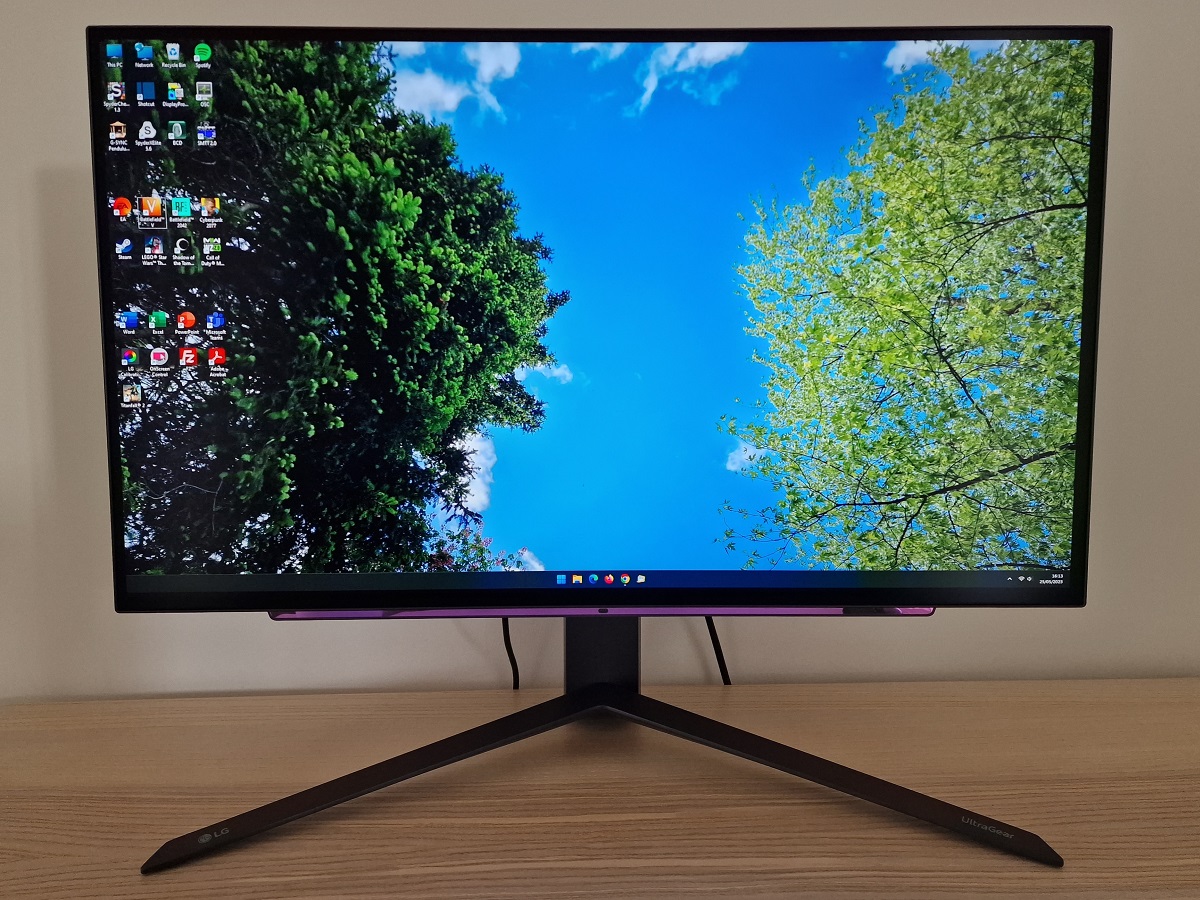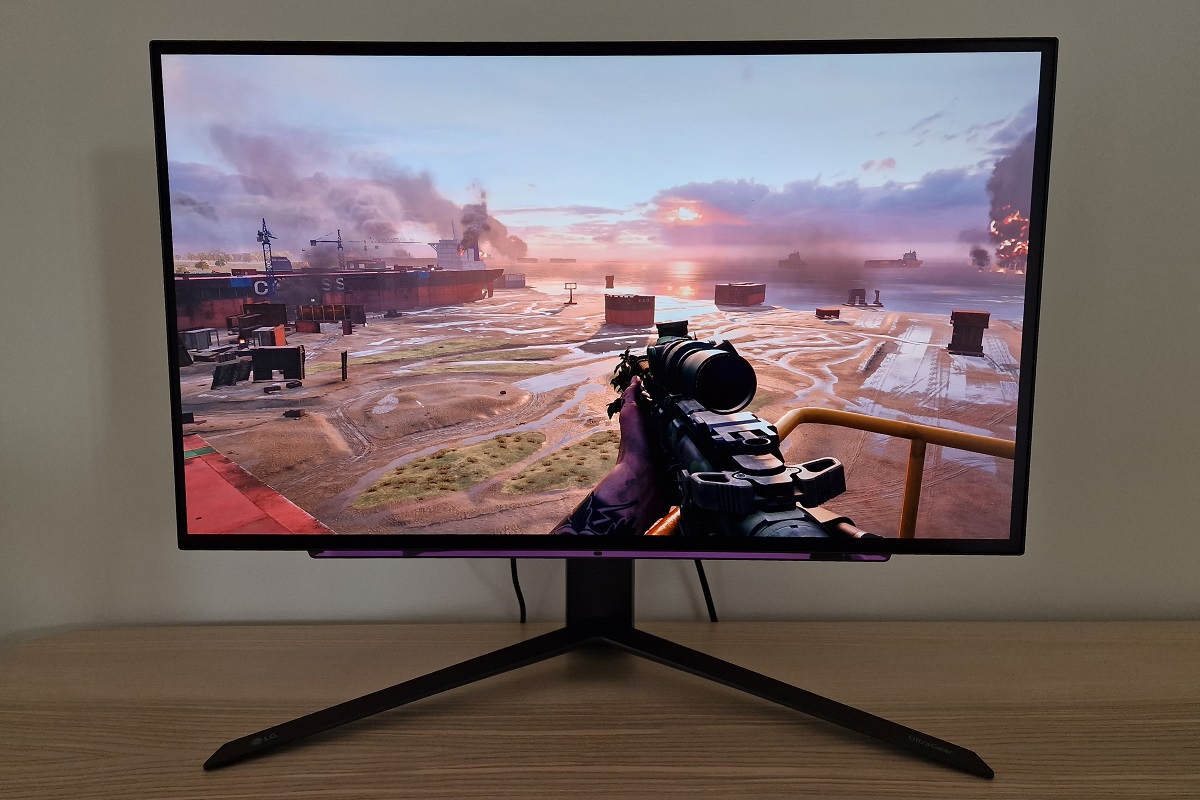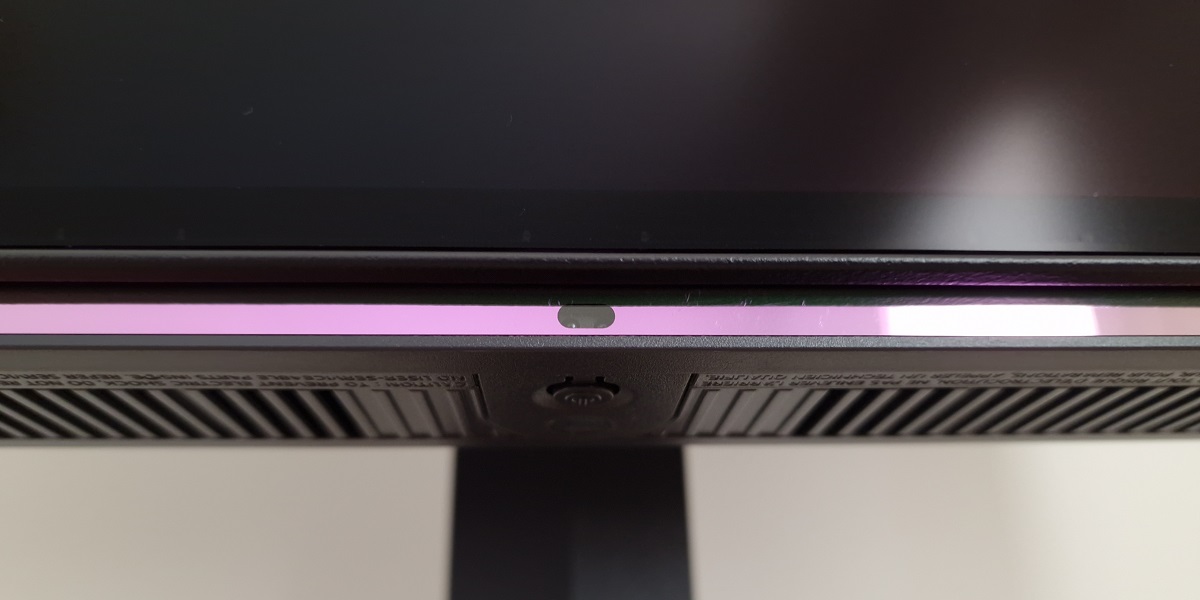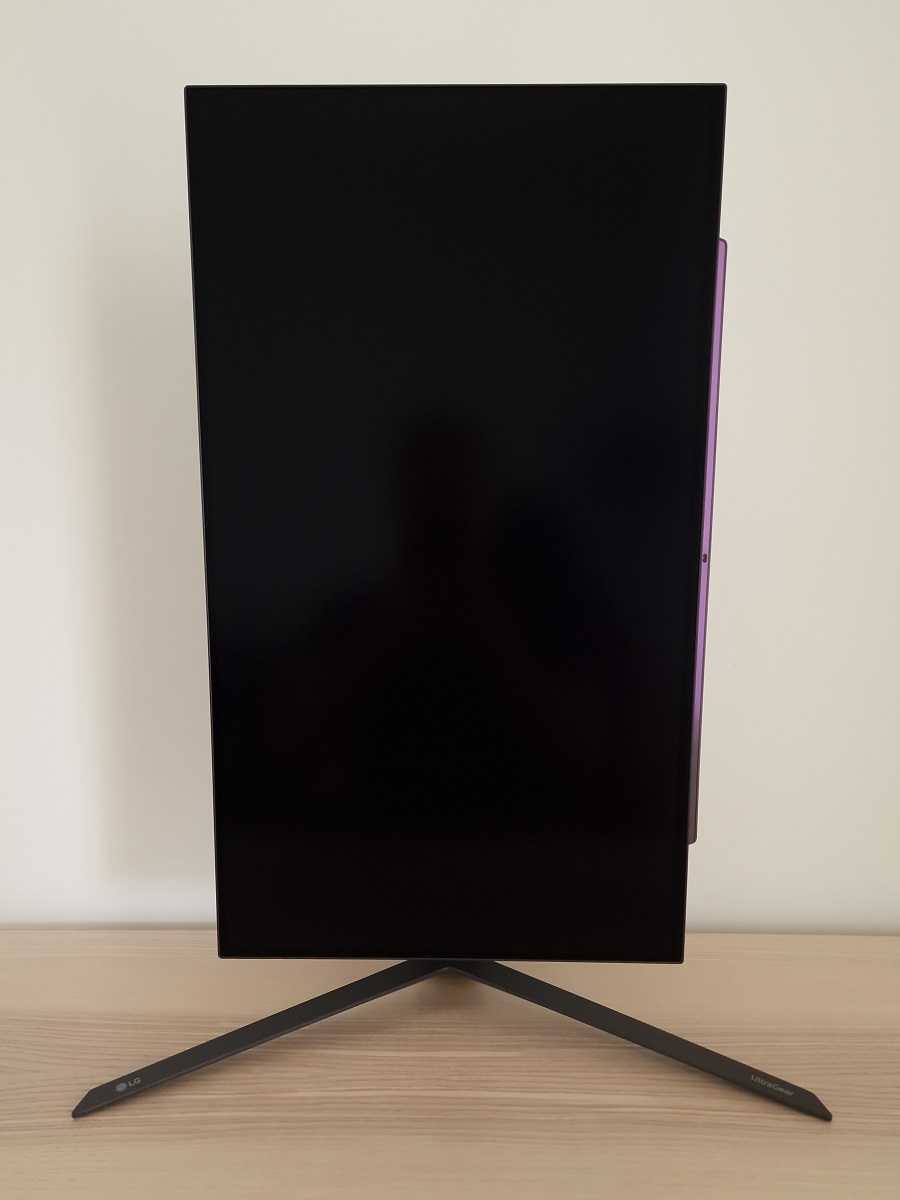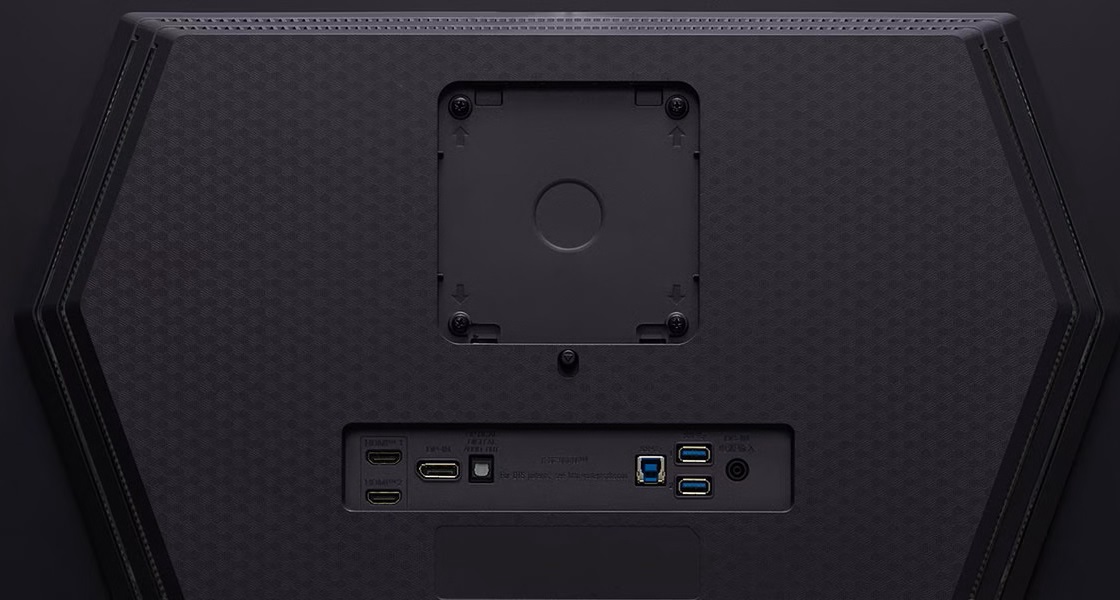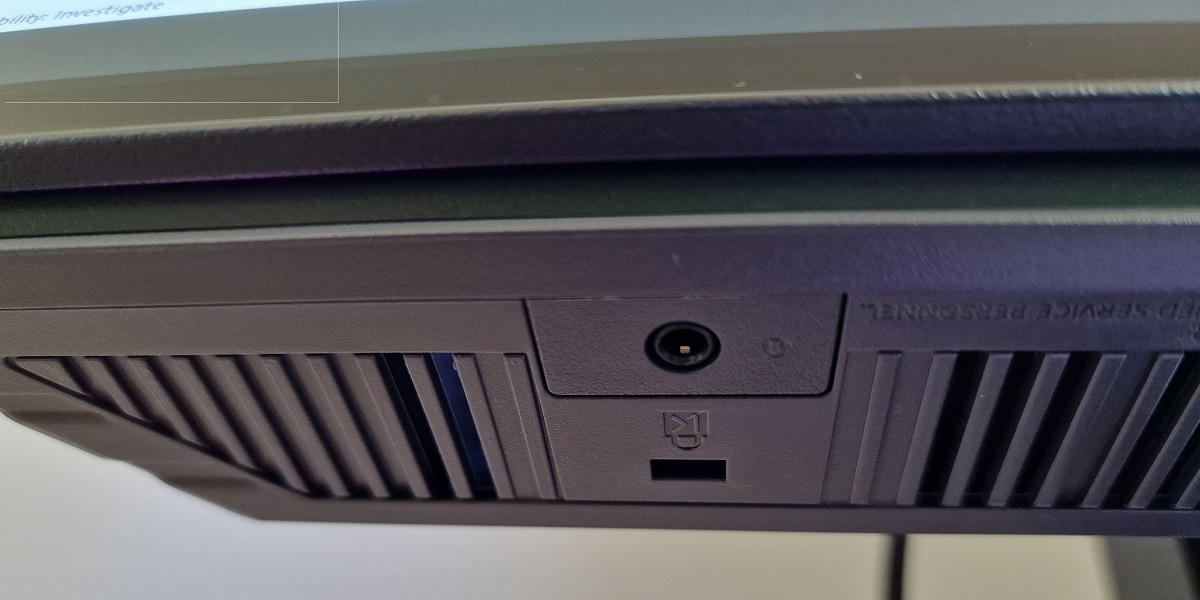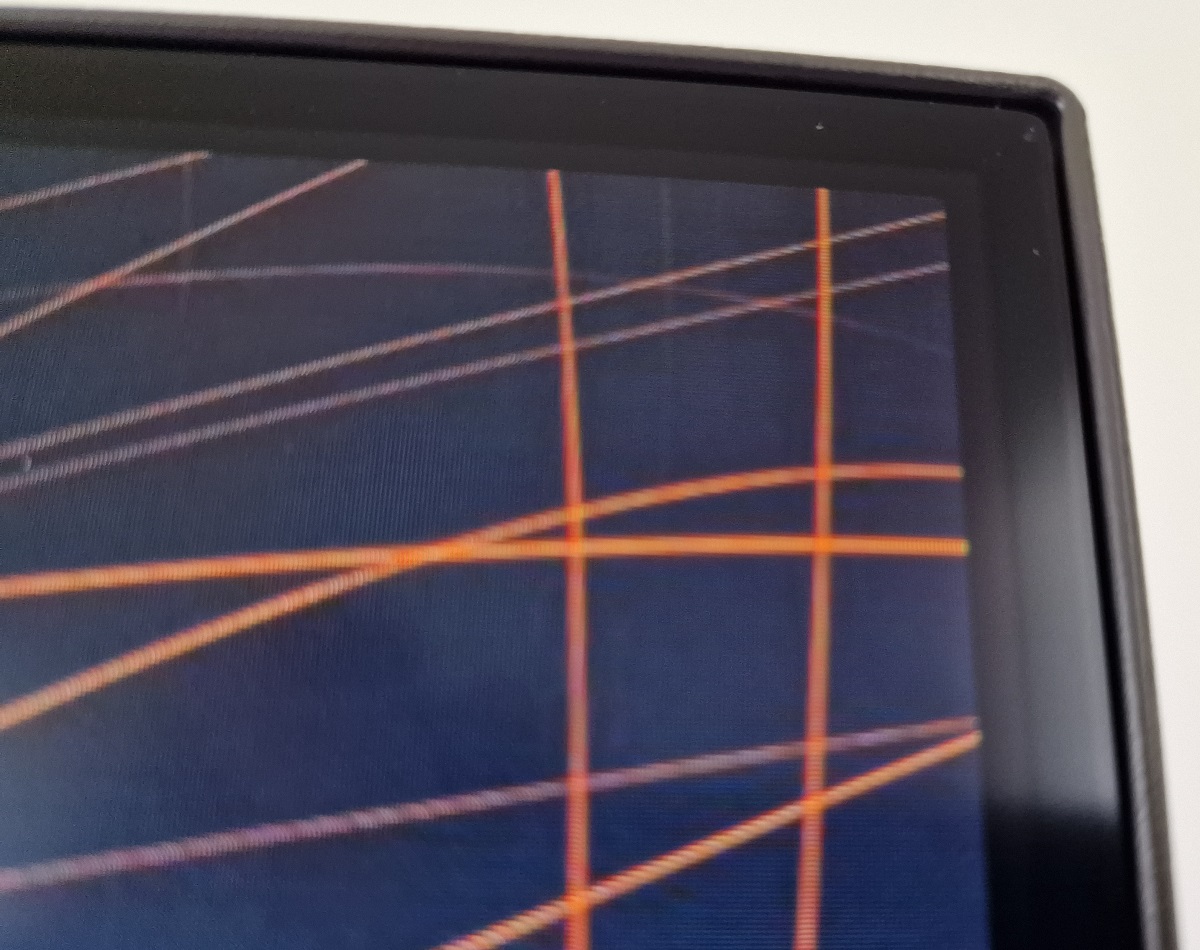Author: Adam Simmons
Date published: June 2nd 2023
Table of Contents
Introduction
OLED monitors have been slow to infiltrate the market, with many manufacturers simply taking advantage of the cross-over between TV and monitor market with very large panels. The LG 27GR95QE (27GR95QE-B owing to the mainly black rear) of the UltraGear series is one of the models specifically designed as a monitor, using a 26.5” (often marketed as 27”) QHD OLED panel. The monitor boasts the usual OLED benefits such as exceptionally strong contrast and pixel responsiveness, with a wide colour gamut and some good boxes ticked for a dynamic HDR experience. We put this monitor through its paces in our usual suite of tests, including desktop usage, gaming and video content.
Specifications
The monitor uses a 26.5” WOLED panel from LG Display, with 2560 x 1440 resolution and a 240Hz refresh rate offered. 10-bit colour is supported, whilst a 0.03ms grey to grey response time is specified – we often say to pay little attention to such figures, though OLED technology is known to be very strong in this area. The key ‘talking points’ for this monitor have been highlighted in blue below, for your reading convenience (as you can see – there are many).
The monitor has a homely look, with dark matte plastic stand neck and ‘penguin foot’ base. The stand base is coated metal, giving a bit of a weighty and premium feel to things. The top and side bezels are dual-stage, with slim panel border flush with the rest of the screen and thin hard plastic outer part – ~6.5mm (0.26 inches) including both components. The bottom bezel is also dual-stage, but thicker – ~10mm (0.39 inches) including both parts. It also has an underhanging glossy sensor unit which spans most of the length of the bezel, providing a total thickness (bezel plus sensor unit) of ~20mm (0.79 inches). This sensor unit includes an IR sensor used for the included remote control and houses some of the monitor electronics. There’s a lilac tint to this bar, with some other shades invited depending on lighting and the colour of objects reflected on it. The screen also has a slim ‘active area’ between the panel border and the image which the entire image periodically moves around in if the ‘Screen Move’ feature (explored shortly) is active – a few mm thick or so. The screen itself is the main feature from the front – this has a medium or ‘relatively light’ matte anti-glare screen surface, as explored shortly. The OSD (On Screen Display) is controlled by a remote control. There’s also a joystick facing down beneath the central region of the bottom bezel, but this only offers very limited functionality. It’s illuminated as part of the ‘Hexagon Lighting’ when the monitor is switched on – disabling the lighting feature will disable the power status indicator when the monitor is switched on, too. Requiring the use of this remote to access all OSD options is certainly an odd decision – if you lose this, damage it or it runs out of battery (and you don’t have spares) then there’ll be a period of downtime where you’re unable to access most of the OSD. The video below runs through the menu system and its functionality, including the ‘Hexagon Lighting’ feature and the options available via the remote, the OSD and ‘OnScreen Control’ software. It also explores the changes we made for our ‘Test Settings’, covered later in the review. The monitor includes a small cooling fan, which we didn’t find bothersome during normal use of the monitor. We could faintly hear the fan if the room was quiet and we weren’t listening to content, but it’s a low-powered fan and we didn’t hear obvious mechanical noises, hissing or other bothersome frequencies from it. It ramped up to become potentially more noticeable if the monitor runs at higher brightness, under HDR. Though even there, it didn’t stand out in an obvious way over our usual system load noise – and our system is beneath the desk and not obnoxiously loud. Everybody’s hearing and sensitivity to various frequencies differs, some people will have particularly quiet systems and there’s the potential for inter-unit variation, however. This contrasts with the ASUS PG27AQDM which uses a heatsink for passive cooling. OLED technology is often associated with a potential image retention or ‘burn-in’ risk. This can include temporary afterimages which are shown on the screen (image retention), or in more severe cases and over a longer period it can include permanent damage (‘burn-in’). The monitor includes a few integrated features designed to offer some degree of protection from image retention or burn-in, which are located in the ‘OLED Care’ section of the OSD. ‘Screen Saver’, which will dim the screen if static content is detected and eventually stop displaying an image. For the dimming, it’s far less aggressive than the sort of ASBL (Automatic Static Brightness Limiter) feature commonly found on OLED TVs such as the LG C2 series and less likely to activate. If the signal (contents on the screen) changes very little for a few minutes, the screen will dim – unless it’s already set to a very low brightness. It will stop displaying an image at all after 10 minutes. Slight changes such as the system clock changing or a small blinking cursor on the screen won’t prevent the feature from activating – we found this feature effective at dimming the screen and eventually blanking the image when not in use and not annoying us by activating when we didn’t want it to. It sprung back to life quickly if we just moved the mouse a bit, for example, whether the screen had dimmed or gone completely blank. ‘Image Cleaning’, which is a maintenance cycle that the monitor will want to run after each cumulative 4 hours of use (it can also be run manually if required). If this cycle is due to be run, the monitor will do this automatically when the monitor goes into standby (or if you turn it off with the power button) to avoid disruption. If you press the power button to turn the monitor off and the monitor wishes to run the cycle, it will prompt you with a message that it will want to run the cycle. If the monitor enters standby and you haven’t pressed the power button, it will also display a message and run the cycle shortly afterwards. The cycle lasts around 10 minutes but can be interrupted if required by waking up or powering on the monitor. The monitor will give you a message on the screen when you turn it back on if it has successfully completed a cleaning cycle. ‘Pixel Cleaning’, which is a deeper maintenance cycle that the monitor will want to run after each cumulative 500 hours of use (it can also be run manually if required). The way it will run and messages work in much the same way as the ‘Image Cleaning’ cycle. The cycle lasts around 1 minute – it involves more significant and aggressive voltage cycling despite being much quicker. Our general recommendation would be to allow the monitor to run its maintenance cycles as requested, when you’re not using the monitor. Try to avoid manually running these unless you feel it’s absolutely necessary – especially the deeper ‘Pixel Cleaning’ cycle which could be detrimental to the lifespan of the monitor if run too frequently. You should also keep ‘Screen Saver’ active, unless you find it’s dimming the screen when you don’t want it to for some reason. We’d also recommend setting Windows to ‘Turn off the display’ after a short period of time. Unlike the monitor’s ‘Screen Saver’ feature, this won’t help if you’re running a full screen application – for example if you pause a game and the screen is almost entirely static. But it will allow the screen to go into standby when left idle on the desktop and run its maintenance cycles if required. You should try various ‘Screen Move’ settings and see if you find the setting unobstrusive, in which case we’d recommend leaving it enabled. We sometimes find this sort of feature annoying due to very frequent shifting of the screen (e.g. on the PG27AQDM), but in this case we found the screen movement occasional and slight enough not to be annoying. So we let the monitor run its maintenance cycles as required, used ‘Screen Saver’ and set ‘Screen Move’ to ‘Mode 1’ – though the other modes also seemed fine. We set Windows to ‘Turn off the display’ after 20 minutes of inactivity but didn’t take any additional precautions during the review such as auto-hiding the taskbar or turning the monitor off as soon as we left the room. We’d suggest considering a shorter period than 20 minutes before the display is set to turn off, but this was a practical time to use for reviewing purposes. You may wish to set the taskbar to auto-hide as an additional precaution, as this is content which will remain largely static when on the desktop. If leaving the taskbar active we’d recommend selecting a dark theme (e.g. in ‘Personalisation’ – ‘Colours’ select ‘Dark’ for ‘Choose your default Windows mode’). We didn’t experience any ‘burn-in’ or even mild image retention when using the monitor over the review period. Though this was limited to a few weeks and clearly doesn’t represent long-term use of the monitor. This monitor uses a medium or ‘relatively light’ (so slightly lighter than some we’d classify as ‘medium’) matte anti-glare screen surface. The screen surface texture isn’t as smooth as some matte surfaces, imparting a bit of a grainy look to brighter content. There’s also some layering in front of the image, which is to say you might become somewhat more aware of the structure of the screen surface in front of the image compared to significantly lighter matte screen surfaces. It shows these characteristics more strongly than most ‘competing’ IPS models, which use light or very light matte screen surfaces. The monitor offers relatively strong glare-handling, diffusing ambient light quite heavily across the screen surface. You don’t need to worry about reflections as you will see with glossy screen surfaces in some environments. And even with fairly strong light striking the screen directly you don’t get the same sharper glare patches you may see on light to very light matte screen surfaces. The diffused ambient light creates a hazing of the image, however. The screen surface doesn’t exhibit the colourful lightening up we observed on the QD-OLED AW3423DW (right, first photo) from a normal viewing position, though this is observed with a gold to purple tint from a sharp angle and with strong light striking the screen surface (second photo). These photographs show a PG27AQDM, which uses exactly the same panel and screen surface as the 27GR95QE.
*10-bit and 12-bit can be selected in the graphics driver at any refresh rate, up to the native resolution using DP 1.4 (with DSC) or HDMI 2.1 under SDR or HDR. 12-bit includes an additional 2-bit dithering stage applied by the monitor’s scaler to facilitate viewing 12-bit content. The bit depths listed here are using a Full Range RGB signal.
As an Amazon Associate I earn from qualifying purchases made using the below link. Where possible, you’ll be redirected to your nearest store. Further information on supporting our work.
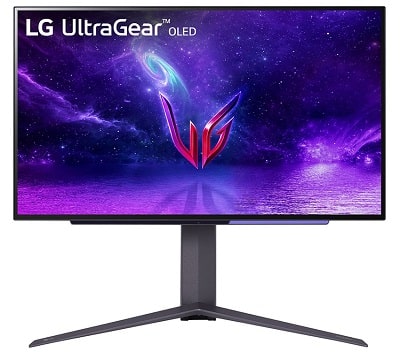
Features and aesthetics
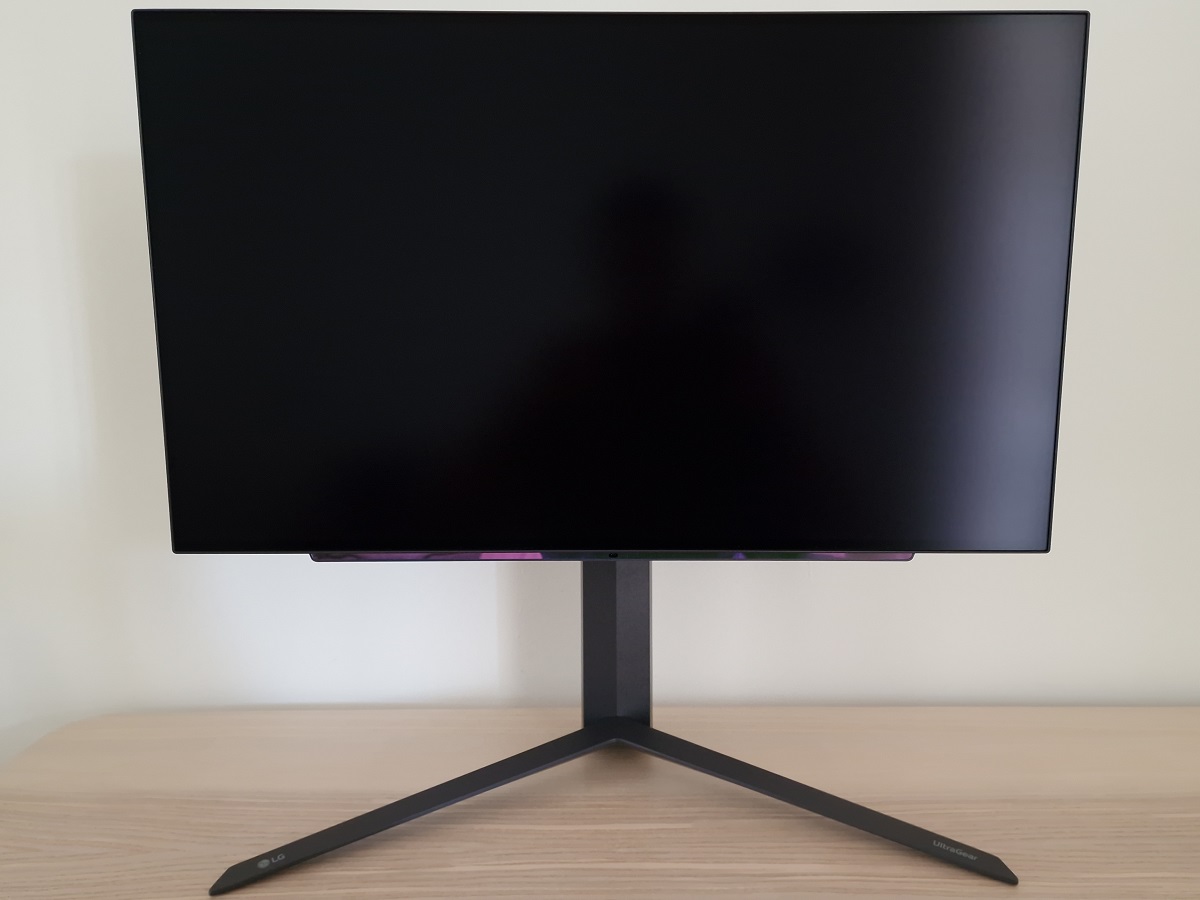

The screen is very slim at thinnest point (~4.5mm or 0.18 inches), but bulks out further for most of the screen to ~45mm (1.77 inches). The stand is fully adjustable, albeit with a more limited range of motion than some models, offering; tilt (5° forwards, 15° backwards), swivel (10° left, 10° right), height adjustment (110mm or 4.33 inches) and pivot (90° counterclockwise into portrait). The height adjustment felt quite smooth, with the other adjustments slightly grabby – though our unit was brand new and this could loosen up over time. The stand was slightly wobbly when firmly nudged from the side, due to the attachment point at the stand being fairly slim. But this was not too bad and we don’t have concerns that typing on a slightly unsturdy desk should cause it to wobble. At lowest stand height the bottom edge of the screen’s sensor unit sits ~103mm (4.05 inches) above the desk surface, with the top of the screen ~460mm (18.11 inches) above the desk – or ~465mm (18.31 inches) accounting for the stand neck poking up above the top of the screen slightly. The total depth of the monitor including stand is ~260mm (10.24 inches), with the screen sitting ~70mm (2.76 inches) back from the frontmost point of the stand. The screen takes up a moderate but not huge amount of desk depth and the screen can be placed reasonably close to the wall. This means it’s a bit more practical than some designs if you don’t have a particularly deep desk.
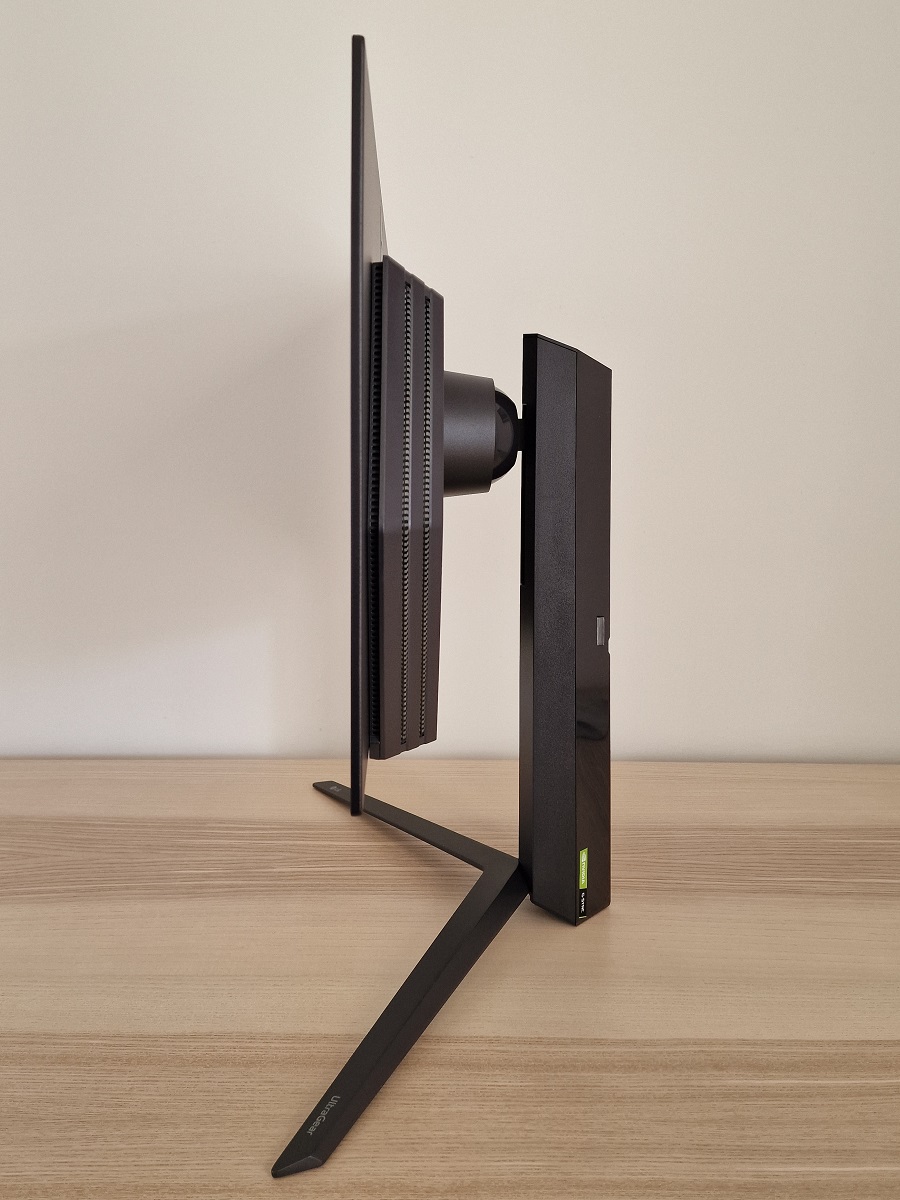
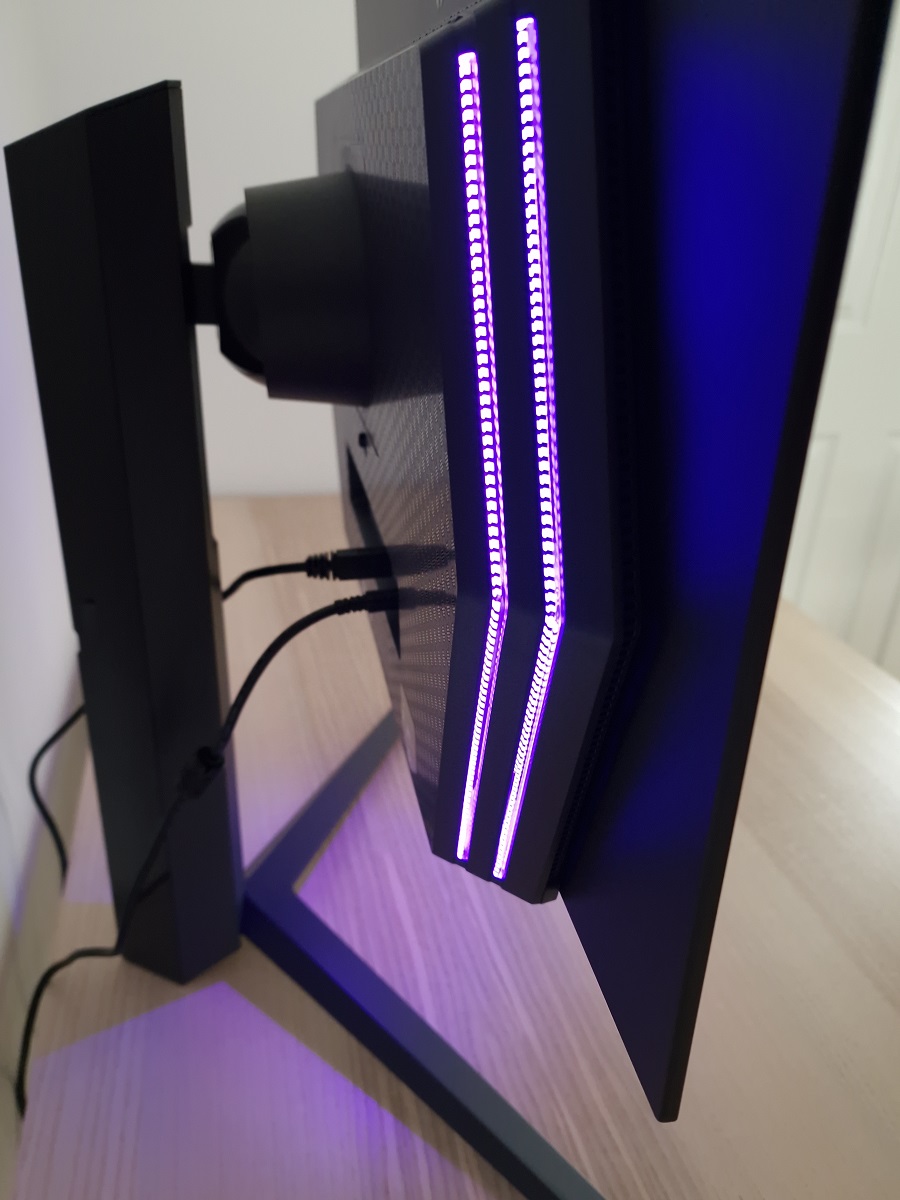
The rear of the monitor is mostly matte black plastic, with a shiny lilac logo in the top central region. 2 rows of RGB LEDs are found to the left and right of the central region of the screen – this so-called ‘Hexagon Lighting’ feature only covers 4 sides rather than including the top and bottom section. It’s explored in the OSD video and as noted there it can provide a small touch of ambience but is too dim to be appreciated in any meaningful way from the front – most noticeable is the small pool of light on the desk from the power LED, with just a little light illuminating the wall behind the monitor. The stand attaches centrally with a quick-release catch (push downwards to release) beneath the attachment point. Removing the stand reveals provision for 100 x 100mm VESA mounting. The ports are located beneath that and include; 2 HDMI 2.1 ports, DP 1.4 (with DSC), 2 USB 3.0 ports (plus Type-B upstream) and an AC power input (internal power converter). There are no integrated speakers on this model, but a 3.5mm headphone and microphone combo jack with DTS Headphone:X support faces downwards at the left side of the bottom bezel (as viewed from the front). A K-slot is also found in this region.
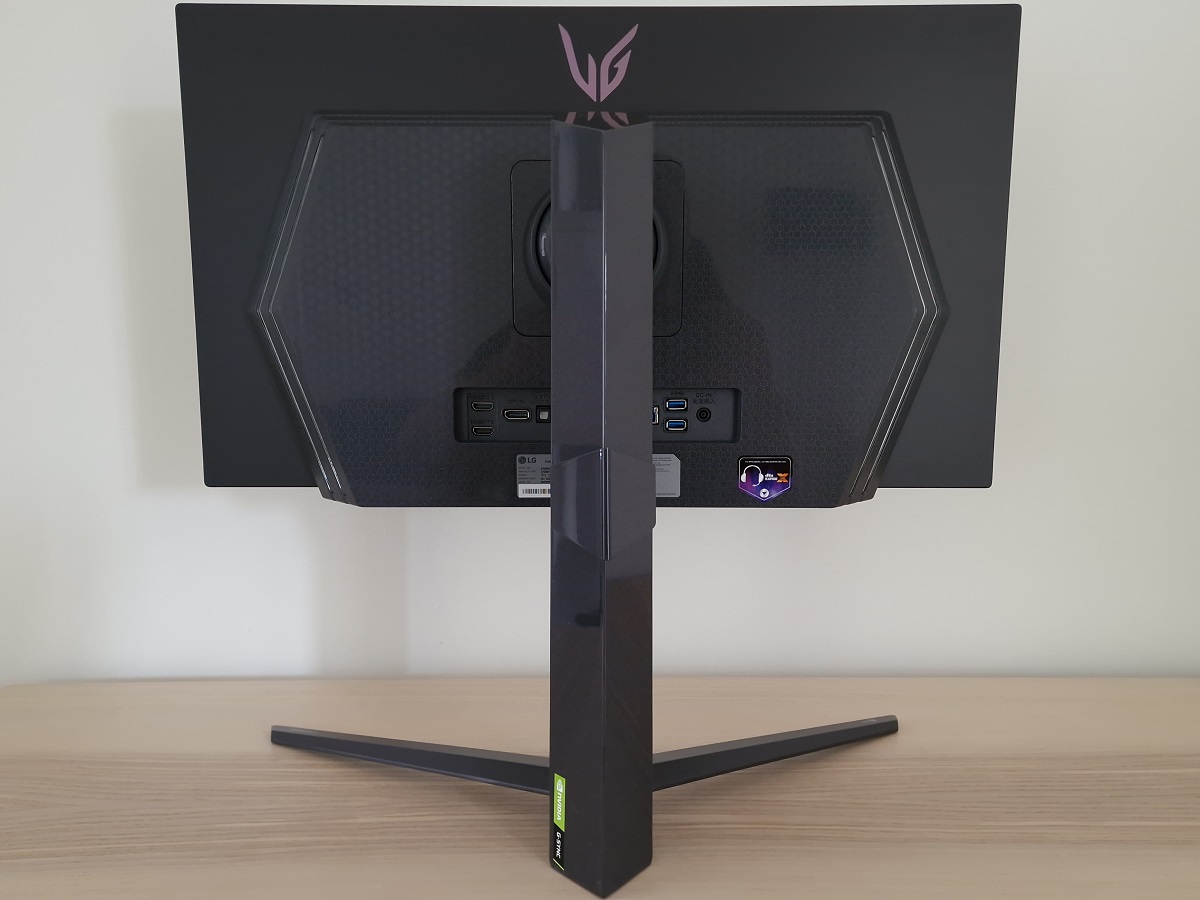
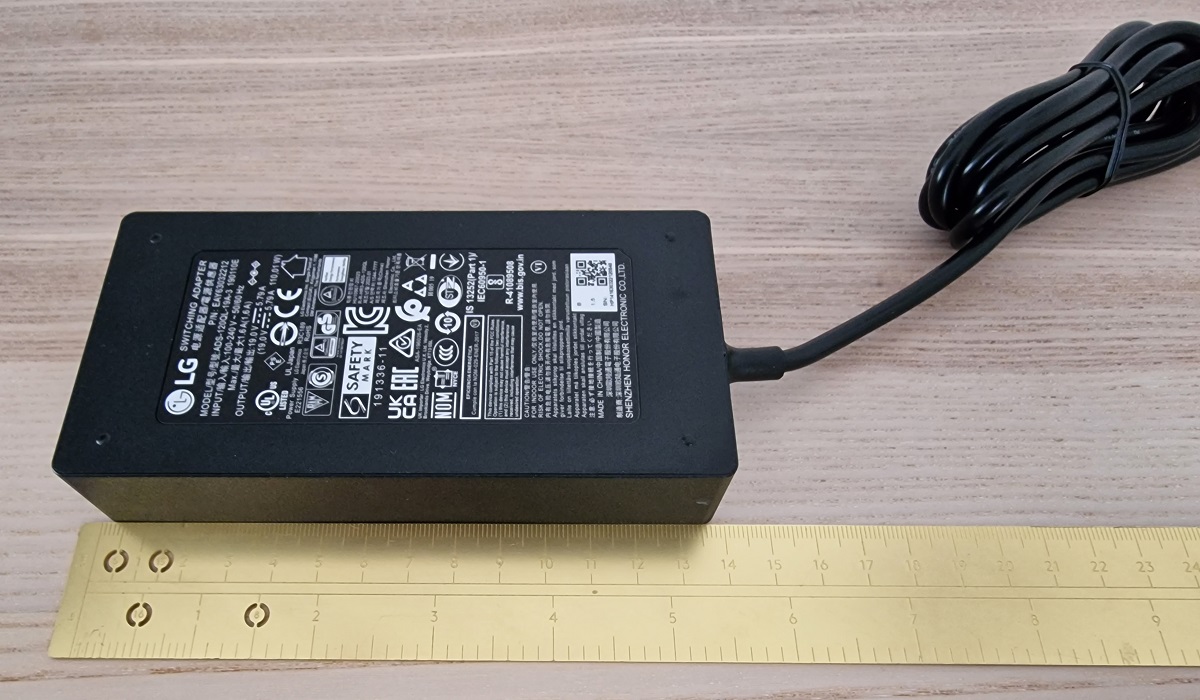
2560 x 1440 @240Hz plus HDR and Adaptive-Sync can be leveraged via DP 1.4 (with DSC) and HDMI 2.1. AMD FreeSync Premium and Nvidia’s ‘G-SYNC Compatible’ is supported on compatible GPUs and systems via suitable versions of DP and HDMI. Compatible Intel graphics hardware can also leverage Adaptive-Sync. HDMI 2.1 includes integrated VRR (Variable Refresh Rate) capability which does not rely on Adaptive-Sync and can be used via ‘G-SYNC Compatible’ and the PS5 which doesn’t support Adaptive-Sync. The image below shows the refresh rates supported for the native 2560 x 1440 (QHD or 1440p) resolution, with the same options available via suitable versions of DP and HDMI.
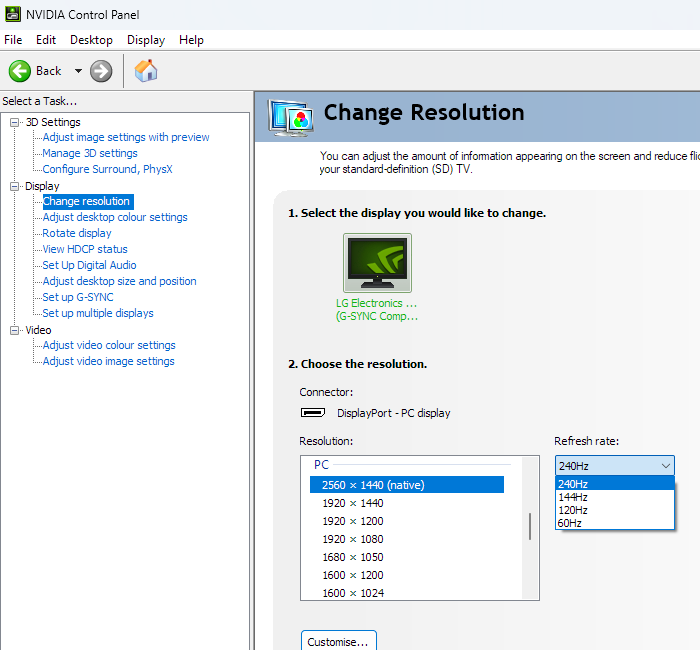
The images below show the refresh rates supported for 1920 x 1080 (Full HD or 1080p). The first and second images show the resolutions categorised in the EDID of the monitor as ‘TV’ resolutions and listed here under ‘Ultra HD, HD, SD’ (DP and HDMI, respectively). The third and fourth images show resolutions categorised in the EDID and listed here as ‘PC’ resolutions (DP and HDMI, respectively).
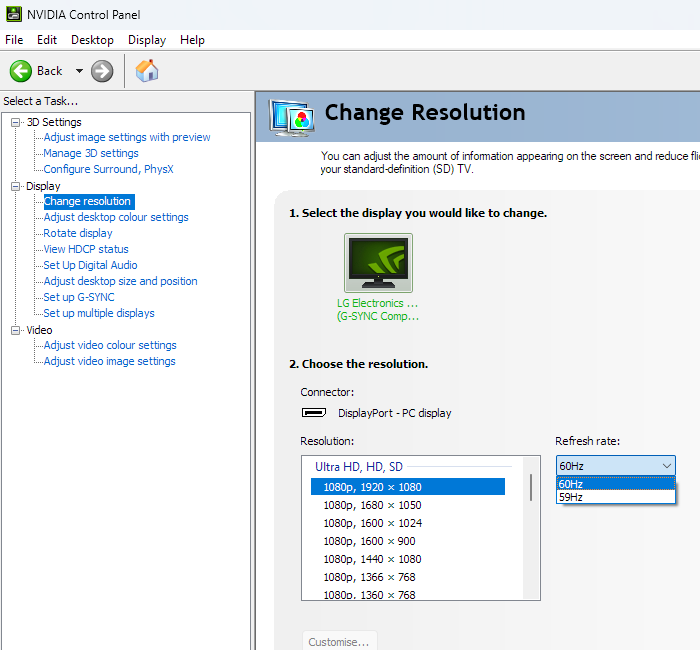
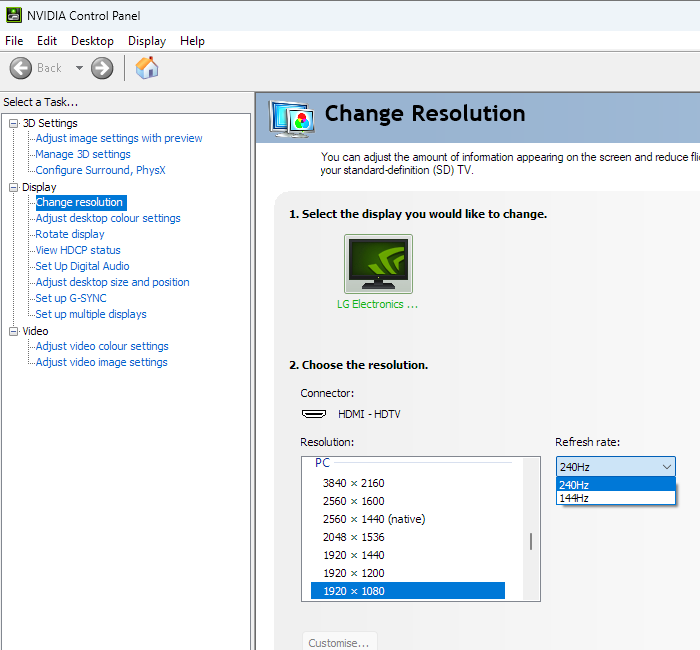
A ‘4k x 2k, 3840 x 2160’ downsampling mode is included via HDMI at up to 120Hz, with the first image showing the ‘TV’ resolution list and the second image the ‘PC’ resolution list. With HDMI 2.1, games consoles like the Xbox Series X and PS5 are able to run up to 3840 x 2160 @120Hz using this ‘4K’ downsampling mode. In the case of the Xbox Series X this also allows HDR to be used as that console doesn’t support HDR at lower resolutions. The HDMI 2.1 ports of this model are full bandwidth (48Gbps), which means the PS5 can use its maximum supported ‘4:2:2’ signal for ‘4K’ UHD @120Hz, with PCs and the Xbox Series X using their fully supported Full Range or ‘4:4:4’ signal.
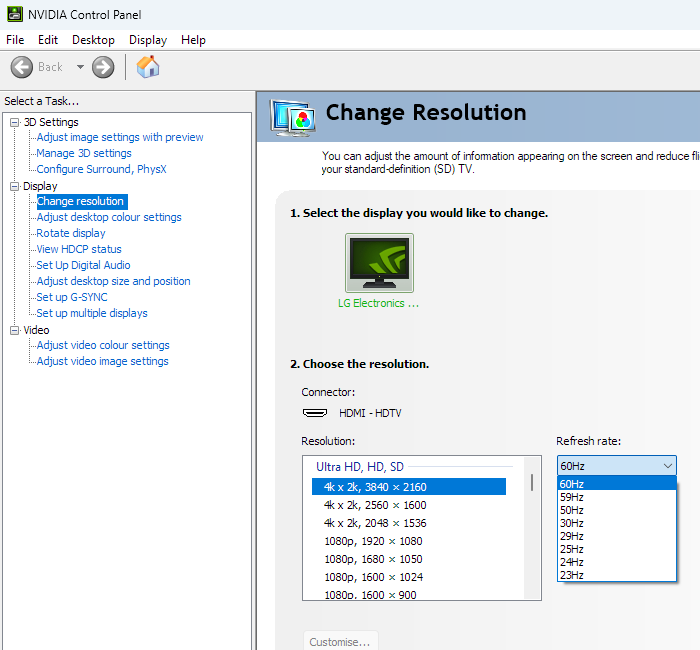
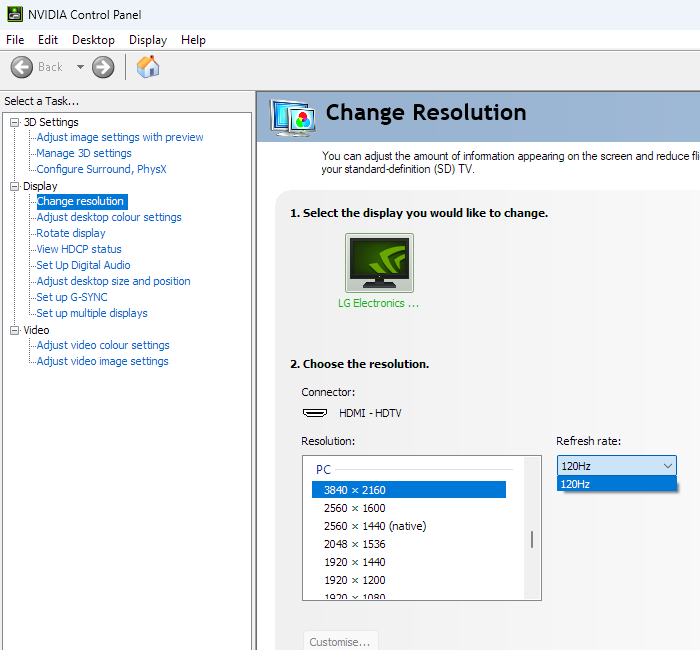
If you’re intending to use the monitor with the PS5 or Xbox Series X/S, be aware that a small settings tweak may be required to ensure 120Hz is selectable for supported resolutions. Details can be found in this article.
Image Retention and burn-in
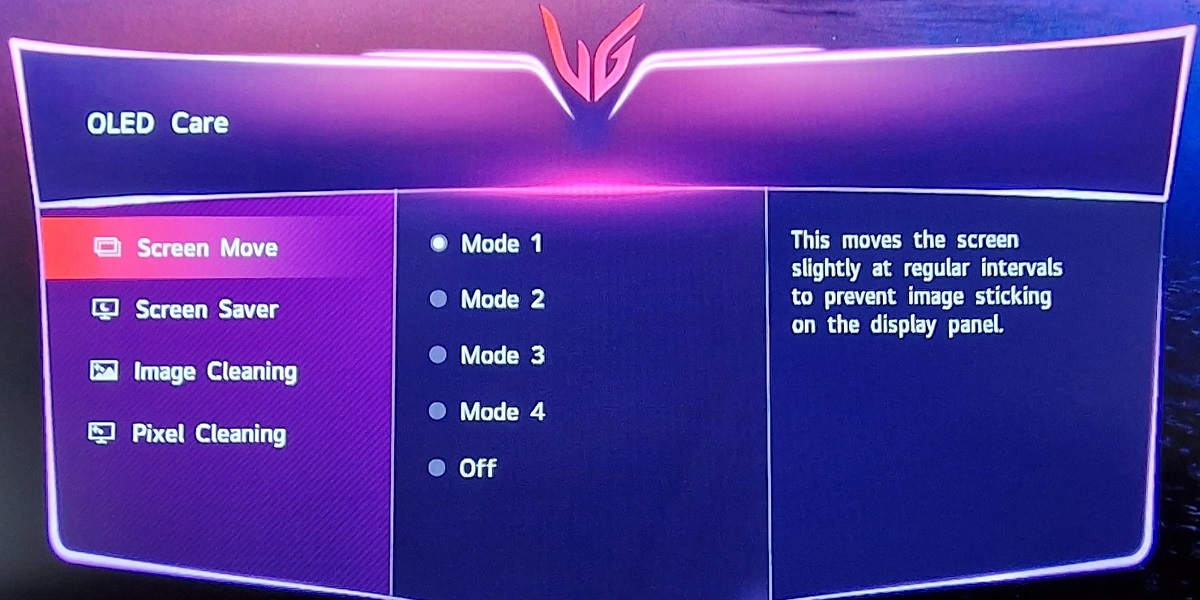
‘Screen Move’, which occasionally nudges the entire image over very slightly. There are 4 ‘Modes’ which we assume changes the ‘nudging’ behaviour in some way or perhaps the interval at which it occurs. This was difficult to assess as you can’t force it to nudge the pixels at will and there is no explanation in the manual of what these different modes do. When the image is shifted it only moves very briefly and it only seemed to happen occasionally. To accommodate this, there’s a small ‘active area’ between the image and bezel, as shown in the image below. This was taken with high exposure plus light striking the screen, so the area could be seen against the bezel and sliver of panel border, but it isn’t something you’d generally find bothersome when using the monitor normally.
Calibration
Subpixel layout and screen surface
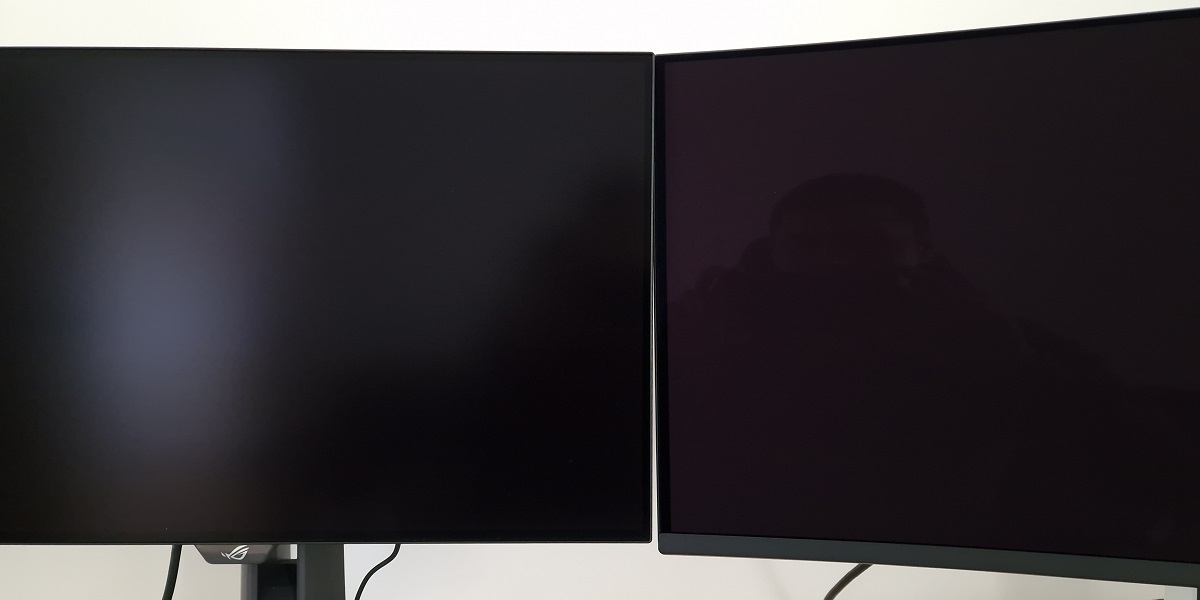
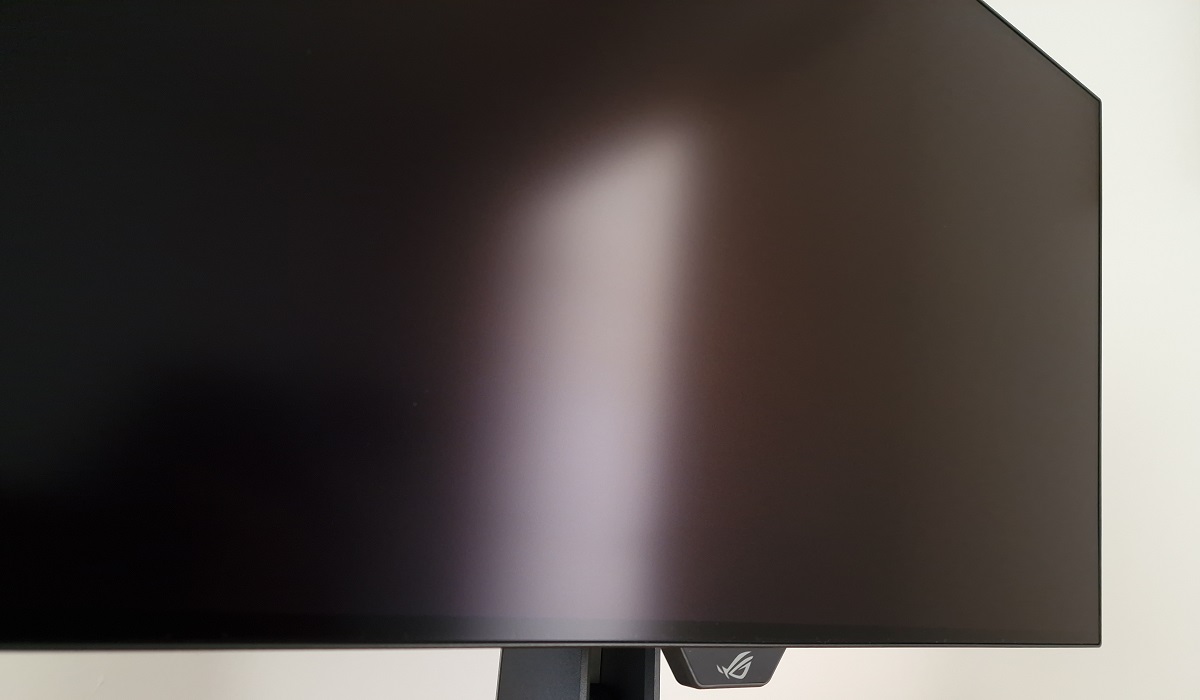
The first image below is a macro photograph taken on Notepad with ClearType disabled. The letters ‘PCM’ are typed out to help highlight any potential text rendering issues related to unusual subpixel structure, whilst the white space more clearly shows the actual subpixel layout alongside a rough indication of screen surface. The second image shows a vertical stripe with single pixel ‘dots’ of red, white, blue and green to better show the ordering of the subpixels of the panel used here. The monitor uses an RWBG subpixel layout (sometimes inaccurately referred to as WRGB or other variants such as RWGB with incorrect ordering), with an ‘unfiltered’ (white) subpixel in addition to the usual R, G and B. Most Windows users will be used to the representation of text using ClearType, which is enabled by default and has been for many years. You can optimise this for RGB or BGR, but not specifically RWBG, with additional tweaks according to taste. For the first sample set on ‘ClearType Text Tuner’ (1 of 5) we’d recommend selecting the first option which will optimise for RGB rather than BGR – the latter appeared to give an even more fringed appearance to text with a more noticeable displacement to the fringe. For the remaining options it really comes down to personal preferences. Our fringing article specifically looks at the issues related to this RWBG subpixel layout, including some linked to ClearType and some that extend beyond text and have nothing to do with subpixel rendering.
![]()
![]()
WOLED subpixels individually lit
Testing the presets
The LG 27GR95QE features a range of ‘Game Mode’ presets; ‘Gamer 1’, ‘Gamer 2’, ‘FPS’, ‘RTS’, ‘Vivid’, ‘Reader’, ‘HDR Effect’, ‘sRGB’, ‘Color Weakness’, ‘Calibration 1’ and ‘Calibration 2’. These make various changes to the OSD, with ‘Gamer 1’ and ‘Gamer 2’ being the most flexible and most of the remaining presets locking off various settings. We briefly explore these presets in the OSD video and will be looking at a few of these plus a range of manual adjustments in this section. The monitor supports hardware calibration under SDR, facilitated using the ‘Calibration 1’ and ‘Calibration 2’ presets alongside free to download ‘LG Calibration Studio’ software. This supports a range of calibration devices, including the SpyderX Elite and i1 Display Pro Plus (Calibrite ColorChecker Display Plus) we use in this review. This video gives a run through of this software and the hardware calibration process.
The table below shows white point and gamma readings taken using a Datacolor SpyderX Elite colorimeter, alongside general observations made by eye. Our test system uses Windows 11 with an Nvidia RTX 3090 connected using the supplied DP cable. Additional testing was performed via HDMI and also using an AMD Radeon RX 580, but observations on this table didn’t differ significantly between inputs or GPUs. The monitor was left to run for over 2 hours before readings were taken and observations made, without any additional monitor drivers or ICC profiles specifically loaded. We had also used the monitor for several days prior to taking these readings as OLED monitors can have a settling period and our unit was very new at time of review. Aside from our ‘Test Settings’, where various adjustments were made, assume factory defaults were used. An exception was that contrast was set to ’60’ and ‘Smart Energy Saving’ was disabled, where possible. This setting is designed to reduce power consumption by dimming the screen depending on the content displayed. You can’t disable this setting outside of ‘Gamer 1’. The monitor was set to 240Hz in Windows, although this didn’t significantly affect the values or observations in this table. When viewing the figures in this table, note that for most PC users ‘6500K’ for white point and ‘2.2’ for gamma are good targets to aim for. Individual targets depend on individual uses, tastes and the lighting environment, however.
Preset Mode Gamma (central average) White point (kelvins) Notes Gamma = Mode 2 (Factory defaults) 2.2 9302K Vibrant but a very cool and icy tint. Strong colour consistency, gamma tracks ‘2.2’ curve well in most places, a bit high for dark shades. Gamma = Mode 1 2.0 9659K As above but lower gamma, giving quite a washed out appearance. Gamma = Mode 3 2.3 9655K As defaults with slight extra depth due to higher gamma. Gamma = Mode 4 2.1 9616K As defaults but gamma slightly reduced, making some shades a bit brighter. sRGB 2.2 7045K An sRGB emulation setting, clamping the gamut closer to sRGB. Saturation and vibrancy reduced with more faithful output of standard sRGB content. The image appears a bit cool-tinted by default, but that can be adjusted. Color Temp = Warm 2.2 7054K As factory defaults with reduced (but still higher than 6500K) white point, giving a less extreme cool tint. Reader 1.8 5542K An obviously flooded look to the image due to extremely low contrast and raised black point. A warm tint with reduced blue light output – a moderately effective Blue Light (LBL) setting. Color Temp = Manual - W8 2.3 4345K A highly effective LBL setting with significantly reduced blue channel, strong red channel and green channel some way between. The image appears with a mild green tint, one we found our eyes adapted to quite readily. Test Settings (see below) 2.2 6448K A few adjustments which provide better balance than factory defaults, with slight but welcome uplift to dark shade visibility and corrected white point.
Straight from the box the monitor is set to ‘Gamer 1’, which uses the full native gamut of the screen. Things appeared vibrant with a strong cool tint – white point was far too high. Gamma averaged ‘2.2’ and tracked the curve very well overall. The gamma was a bit high for dark shades, meaning dark detail was slightly more masked than it should be. This was alleviated somewhat by raising ‘Black Stabilizer’ to ‘55’. There were slight gamma changes if brightness was adjusted, but these were not significant and could be partly accounted for by the ABL (Automatic Brightness Limiter) behaviour, explored later. These weren’t the sort of gamma fluctuations (perceived or read) that we observed on the AW3423DW. The graph below shows gamma tracking under our ‘Test Settings’. Note that the graph just gives a general idea of gamma behaviour but lacks the precision or resolution to clearly show the slightly raised low-end gamma we described. The correct neutral point for contrast seems to have caused some confusion on this model as different presets have different values set and sometimes contrast is greyed out as an adjustment, so you can’t see what it’s set to. We found that the optimal value for this was ‘60’ on our unit, which is also the default under ‘Gamer 1’ or ‘Gamer 2’. If you raise the contrast, it makes the Automatic Brightness Limiter (ABL, explored shortly) more aggressive and noticeable. By ‘70’ the ABL was relatively strong and caused the monitor to dim significantly when bright shades dominate – this introduced fluctuations during the gamma test procedure, adversely affecting readings. The brightness fluctuations (explored later) are certainly noticeable by eye, but things don’t look as ‘wonky’ as you’d expect from these gamma readings and it’s more an artifact of how gamma is recorded by the colorimeter here. Using the ‘sRGB’ preset which includes sRGB emulation, the contrast was set to ‘70’ by default and this introduced fairly aggressive ABL behaviour, adversely affecting gamma and colour accuracy readings – again, more of an artifact of how the colorimeter records such things. The gamma graphs below show tracking using factory defaults (‘Gamer 1’, 60 contrast), 65 contrast and 70 contrast. It also shows the ‘sRGB’ setting with contrast set to its default value of 70 and with this reduced to 60. Although the readings here do not impact the image in the way you might expect if ABL were removed from the equation and this sort of gamma was recorded, this ABL behaviour was annoying to us by eye and did introduce some unwanted variability in how shades are perceived. Given the intended uses for the monitor, inter-unit variation and generally pleasing performance of our unit with OSD tweaking alone we won’t be using any ICC profiles in this review or including any measurements or graphs using them. We wouldn’t recommend using them unless created for your specific unit using your own calibration device. But we appreciate some users still like to use profiles and some aspects such as gamut mapping for colour-aware applications can be useful. You can download our ICC profile for this model, which was created using our ‘Test Settings’ as a base. You can also download our sRGB profile which was created using and designed for the ‘sRGB’ setting (‘Game Mode’ – ‘sRGB’), with the screen set to ‘100’ brightness and ‘60’ contrast. Note again that these ICC profiles are not used in the review, including for the colour accuracy readings given here. We prefer to analyse things in a more visual and qualitative way, but using the ‘sRGB’ with contrast set to ’60’ we can confirm an average DeltaE of 1.49 (aggressive ABL affected readings with contrast set to ‘70’) within the sRGB colour space recorded with our SpyderX Elite, using the same 24 test patches analysed visually deeper into the review (SpyderCHECKR 24). Note that shade 1F (cerulean) is often recorded with a high error in this test, though it’s still a touch high here. LG doesn’t specify any particular DeltaE for the sRGB setting. This monitor has its peak of blue light shifted to less energetic wavelengths (456nm compared to the more ‘standard’ ~450nm), something that has potential viewing comfort benefits. There are many factors to consider when it comes to viewing comfort and everybody’s eyes are different, however. In addition to this, the monitor includes Low Blue Light (LBL) settings which are designed to reduce blue light output of all wavelengths and create a warmer look. Reducing exposure to blue light can aid viewing comfort, whilst the warmer look to the image can be useful for relaxing viewing. Something that could be particularly beneficial in the hours leading up to sleep. The ‘Reader’ preset acts as a moderately effective Low Blue Light (LBL) effect, giving a warm look to the image. It also massively reduces contrast, designed to stop the amount of time your eyes spend accommodating to changing light levels from the monitor. Some may find this more comfortable, but for others it won’t have a positive effect – the massively reduced contrast and flooded look to the image is unappealing more generally. We preferred setting ‘Color Temp’ to ‘W8’ which acts as a highly effective LBL setting without crushed contrast. The image appeared warm with a mild green tint, though our eyes adjusted to this tint after using the screen for a short period. We used this setting in conjunction with our ‘Test Settings’ (minus colour channel adjustment, which ‘W8’ replaces) for viewing comfort in the evenings. Though not for specific testing aside from that involving this setting. We would usually have assigned this to ‘Gamer 2’ so it’s easy to switch between our ‘Test Settings’ and this one we use for relaxing evening viewing. Unfortunately, we found the ABL a bit strong using that preset and preferred to use this setting with ‘Gamer 1’. The remote at least made it fairly easy to switch the ‘Color Temp’ between ‘Custom’ and ‘Manual – W8’, but being able to use a shortcut would’ve been preferred. Being able to reassign the ‘Reader Mode’ key on the remote would’ve been ideal, for example. For our ‘Test Settings’ we stuck to the factory default ‘Gamer 1’ preset and made a few adjustments, including significant changes to colour channels to remove a significant cool (and slightly green) tint. The colour channels were rather sensitive, so be careful when adjusting them. For example, raising the blue channel from ‘39’ to ‘40’ raised white point from ~6450K to ~6600K on our unit. We also upped the black stabilizer slightly, giving a slight but still welcome uplift to dark detail levels – setting this any higher on our unit introduced strange moving artifacts for some dark shades, as demonstrated in this section of the OSD video. Note that individual units and preferences vary, so these settings are simply a suggestion and won’t be optimal for all users or units. These settings only apply to SDR, HDR has separate settings associated with it (is far more restrictive) and is explored in the relevant section of the review. We used the defaults under ‘Gamer 1’ for HDR. Game Mode = Gamer 1 Adaptive-Sync = On Black Stabilizer = 55 Brightness = 95 (according to preferences and lighting) Color Temp = Custom R = 50 G = 46 B = 39 Smart Energy Saving = Off Refresh rate (Windows setting) = 240Hz Note that the firmware can be upgraded via ‘OnScreen Control’. Our unit was running the latest firmware available at time of review (3.08, 1.17). The update process took just shy of 2 hours when we did it, but this could vary and might also depend the version you’re coming from and upgrading to. An X-Rite i1Display Pro Plus (Calibrite ColorChecker Display Plus) was used to measure the luminance of white using various settings, including those covered in the calibration section. Because of the self-emissive nature of this display, black depth is ‘0’ and contrast ratio essentially infinite as measured with the colorimeter. Black highlights indicate the highest white luminance recorded under SDR. Blue highlights indicate the results under our ‘Test Settings’ and with HDR active. We tested our preferred setting of ‘Gamer 1’ under HDR as well as ‘Gamer 2’, which sets the screen to an extremely cool white point to maximise brightness and oversaturated the image. No other preset exceeded the brightness of ‘Gamer 2’ under HDR, including ‘Vivid’ which not only provides a high white point but also gives an extremely oversaturated and cartoonish look to things. Assume any setting not mentioned was left at default, with the exceptions noted here or in the calibration section. ‘Smart Energy Saving’ was disabled where possible, which specifically requires the monitor is set to ‘Gamer 1’ under SDR. Note: The test patch used under SDR is a fairly large white box (60mm x 60mm) in the centre of the screen, surrounded by a bit of light grey with black text for the UI elements of the program. The desktop background is shown surrounding that complete with desktop icons to the left and the taskbar at the bottom (example from another screen). Unlike some OLED screens, this monitor doesn’t include an aggressive ABL (Automatic Brightness Limiter) under SDR with most settings. However; a mild ABL is used under SDR which is more aggressive with some settings (as explored below). We recorded fluctuating brightness levels depending on the desktop background displayed – a range of wallpapers were observed, as were solid shades including black and white. The brightness range recorded for each setting is provided. We found the fluctuations minor enough not to be annoying using our ‘Test Settings’, even on the desktop. The fluctuations were slightly higher than we recorded on the PG27AQDM using its ‘Uniform Brightness’ setting or the AW3423DW under SDR, but still minor and less annoying than the much more aggressive ABL feature some OLED screens use. **These readings were taken using the above test. A reading was taken using a white screen fill (‘all pixels’), 30 seconds after it was displayed. This is used to represent the sustained luminance level the monitor can provide under HDR, rather than the peak luminance achieved for smaller sections of the screen. Because the entire screen is white for this test, black luminance levels can’t be read and an HDR contrast reading can’t be ascertained. ***These are the highest readings taken for the sun glint on the water surface of this scene from Shadow of the Tomb Raider and the sun in the sky on this scene from Battlefield V. For practicality and to ensure a good peak reading with maximal sensor area coverage, we allowed slight repositioning of the character and perspective change from what is shown in the screenshots. The overall makeup of the scene remained roughly as shown, which is particularly important on models such as OLEDs where brightness can vary significantly depending on the overall levels of light and dark shade in the scene. The monitor provided a peak luminance of 187 – 204 cd/m² under SDR using ‘Gamer 1’, with the least aggressive ABL behaviour. The more aggressive ABL used under SDR with ‘Gamer 2’ with the same settings as ‘Gamer 1’ yielded 203 – 241 cd/m² and the ‘Vivid’ setting which uses extremely aggressive ABL gave 153 – 406 cd/m². In practice the less aggressive ABL behaviour will be preferred by most and the monitor can be considered as reaching ~200 cd/m² with some variation either side depending on the content displayed. This isn’t as bright as the PG27AQDM achieved using its ‘Uniform Brightness’ setting (~260 cd/m²), which uses even less aggressive ABL than ‘Gamer 1’ on the LG. It’s also significantly dimmer than some LCDs will provide, but it’s still sufficient for most users as they’ll generally set their monitor some way between 100 – 200 cd/m² for regular SDR usage. For reference, we recorded 170 – 185 cd/m² with our ‘Test Settings’ at ‘100’ brightness which indicates how bright the monitor can get with colour channels corrected (including ~6500K colour temperature). The minimum luminance recorded was 14-15 cd/m², which is a good low value and should be fine for even quite light-sensitive users who tend to prefer dim settings. There’s more to the ABL behaviour than the range of operation, indicated in this table – and this gets very confusing. If contrast is increased, the screen seems to dim quite aggressively where enough brighter content is displayed – the effect of this dimming is easier to perceive because there’s a lot of bright content on the screen, too. Using a contrast of ‘60’ the monitor spent most of its time near the lower end of what we recorded in the table. As bright shades dominate, brightness increases which is the opposite of what you might expect to happen and the opposite of what happens with raised contrast. In practice this is less noticeable by eye than when the screen dims for this brighter content, as occurs with contrast raised. For ‘Gamer 2’ set up exactly as ‘Gamer 1’, the range of the ABL is increased and it dims for brighter content, even with contrast set to ‘60’. Similar behaviour is observed in the ‘sRGB’ preset with its default contrast of ‘70’, but the ABL is less aggressive with this set to ‘60’. Going back to ‘Gamer 1’, you can control a setting called ‘Smart Energy Saving’. With this enabled, we sometimes noticed that brightness could dip significantly, even if temporarily – this can be particularly noticeable if scrolling through a document or web page with mixed content brightness. As for the calibrated presets, the ABL there behaves more like a toned down ‘Gamer 2’ – so a decrease in brightness where bright shades dominate, but no huge dips like we saw with ‘Smart Energy Saving’ enabled. Under HDR the peak luminance recorded using ‘Gamer 1’ was 665 cd/m² at a 4% patch size and using ‘Gamer 2’ was 910 cd/m² at a 1% patch size. With both settings there was a moderate drop in brightness by a 25% patch size and a further significant drop beyond that, down to 142 cd/m² (‘Gamer 1’) or 152 cd/m² (‘Gamer 2’). We recorded a white point of ~6800K under HDR using ‘Gamer 1’ and ~9100K using ‘Gamer 2’, though the exact white point varies depending on brightness. ‘Gamer 2’ therefore gave a cool and icy look to the image which can accelerate visual fatigue. Coupled with the whacky appearance it gives to the image with upset balance and clear oversaturation, we don’t feel it’s worth using this setting just for the brightness increase. The HDR luminance data for the two brightness settings is shown in the graph below, for those preferring a graphical representation. We record true peak readings here which mean the highest value observed for a given patch size, except for the sustained reading at a 100% patch size. The PG27AQDM which shares the LG’s panel and the QD-OLED Dell Alienware AW3423DW are also included in the graph, for comparison. The 27GR95QE does not use PWM (Pulse Width Modulation) to regulate the brightness of its pixels at any level. Instead, DC (Direct Current) is used to moderate brightness. As is common for OLED screens, the screen uses low amplitude oscillation – so there’s a slight cyclical dip in brightness in sync with the refresh rate, for example every 4.17ms at 240Hz. This was recordable via oscilloscope and can be observed by a camera with certain settings, but is very different to the more pronounced brightness changes accompanying PWM. As such, it shouldn’t be bothersome to most users and the monitor can be considered ‘flicker-free’ as advertised. Sensitive users could potentially find this bothersome, particularly at lower refresh rates. We’ve communicated with some individuals who are particularly sensitive to PWM flickering but find OLED screens with similar brightness regulation comfortable to view, so sensitivity to PWM doesn’t necessarily mean this will be problematic. This monitor uses OLED technology with self-emissive pixels rather than relying on a backlight. As such, there is no backlight bleed or associated clouding. Whilst observing a black background in a dark room, using our ‘Test Settings’, we saw a pure blackness – as if the screen was switched off. The image below shows this for reference, it’s a capture from the ‘dark desktop’ portion of the viewing angles video. Any patchiness in the image or slight apparent lightening of the black background is due to the image capture or slight glare from any ambient light in the room rather than the monitor. The luminance uniformity was excellent. The maximum luminance was recorded at ‘quadrant 2’ above centre (164.1 cd/m²). The greatest deviation from this occurred at ‘quadrant 5’ in the centre (157.3 cd/m², which is 4% dimmer). The average deviation between each quadrant and the brightest recorded point was 2.25%, which is strong. Remember that individual units vary when it comes to uniformity and you can expect further deviation beyond the points measured. But with its lack of backlight and direct emission from the pixels, relatively strong uniformity can be expected in this area.* The contour map below shows these deviations graphically, with darker greys representing lower luminance (greater deviation from brightest point) than lighter greys. The percentage deviation between each quadrant and the brightest point recorded is also given. The SpyderX Elite was also used to analyse variation in the colour temperature (white point) for the same 9 quadrants. The deviation between each quadrant and the quadrant closest to the 6500K (D65) daylight white point target was analysed and a DeltaE value assigned. Darker shades are also used on this map to represent greater deviation from 6500K. A DeltaE >3 represents significant deviation that may be readily noticed by eye. Results here were excellent, with no significant deviations recorded – the top right was recorded as closest to 6500K, with a maximum DeltaE of 1.6 recorded towards the bottom left. Note again that individual units vary when it comes to uniformity and that you can expect deviation beyond the measured points. Also note that this colour temperature measurement doesn’t account for the green channel strength, which can also vary at different points of the screen. This wasn’t a significant issue on our unit, with only minor variation observed. In addition to the quantitative testing above, we performed a subjective assessment of the uniformity of a variety of dark and medium shades, including 5% grey and 50% grey. Some OLED screens are susceptible to uniformity issues such as splotches or obvious striations when viewing large areas of flat shades such as this, giving an inconsistent appearance that some users refer to as ‘DSE’ (‘Dirty Screen Effect’). In this case we observed striations on some shades, mainly vertical but some horizontal as well. Very dark grey shades (such as #0E0E0E) showed this most clearly, though this wasn’t as bad as the patchiness and striations we’ve observed on some VA models. We’ve included a photo of the screen displaying this shade below to give an idea of the level of ‘DSE’ and also a shift in tone to the grey – though this tone shift is somewhat exaggerated in the photo and the level of ‘patchiness’ is also exaggerated due to compression and processing of the image. In practice the shade is much darker than it appears here, but the photo still gives a reasonable idea of some of the striations visible by eye. – The monitor will not automatically run its cleaning cycles with ‘AGING’ set to ‘ON’ (prerequisite for CPC), so they should be periodically run manually. It will not give messages to say the cycle is complete or hasn’t been completed – the ‘hexagon lighting’ will cycle various colours when the cycle is active and stop when complete. The ‘DEBUG module OLED’ section of the service menu shows how long the monitor has been in use since the last ‘Image clean’ (recommended after 240 minutes or 4 hours) and ‘Pixel clean’ (recommended after 30,000 minutes or 500 hours – around 2 months with 8 hours per day usage) cycles have run. – If you run a cleaning cycle, power off the monitor, it loses power because Windows sends it to sleep (‘Turn off display after’) or because a signal is lost CPC will re-enable itself. We found the setting remained enabled if the system was shut down for a brief period, perhaps under an hour. As we explored earlier with respect to screen surface, the contrast is most impressive in a dimly lit room. Our observations below mainly relate to how things appear in dimmer lighting conditions. As the room becomes brighter, you’ll observe glare being diffused across the screen which creates a ‘hazing’ in front of the image. On Battlefield 2042 the monitor delivered an exceptional contrast experience. The per-pixel illumination, coupled with a lack of ‘glow’ of any sort (‘IPS glow’ or ‘VA glow’) gave darker scenes the intended atmosphere. The strong depth to dark shades also helped provide a more defined look, with an inkiness to shadow details and suchlike that contrasted strongly with surrounding medium to brighter shades. Gamma consistency was also very strong, so shade depth and detail levels were maintained well throughout the screen. The visibility was superior to what we saw on the PG27AQDM under SDR, following appropriate OSD tweaking on both models. But not in a way that artificially lifted detail, simply due to more appropriate low-end gamma. The exceptional contrast also provided a solid look to medium shades which goes beyond what you’d see on LCDs – particularly those with TN and IPS panels but also to some extent VA panels. These medium shades look somewhat translucent in comparison on an LCD, particularly if it lacks a highly effective FALD solution with large number of dimming zones. The screen surface imparted a moderate amount of graininess and some layering, so you could become quite aware of the screen surface when viewing lighter content. We made similar contrast observations on Shadow of the Tomb Raider. Here, there are many scenes with contrasting elements such as flames or point sources of light against dark backgrounds. Dark caves, tombs and passageways are common. An appropriate atmosphere was delivered, whilst the depth provided to darker shades aided shadow definition throughout the screen. The screen surface again impeded the image more than some matte offerings, with some layering and moderate graininess when observing brighter content. We observed another title which craves a strong contrast performance – this time the film Star Wars: The Rise of Skywalker. Bright pulses of energy cast against darker surroundings are commonly observed here and the monitor again provided exceptional and appropriate depth and atmosphere. The film is also presented in a letterboxed format with black bars at the top and bottom. The depth of these bars was impressive and therefore they were easy to ignore rather than becoming overly distracting or annoying. Most content you’d consume on streaming media platforms such as Netflix, Amazon Prime Video and Disney+ are presented without black bars. This is certainly the case for YouTube, too, where 16:9 content is very common indeed. The Lagom tests for contrast allow specific weaknesses in contrast performance to be identified. The following observations were made in a dark room. The LG 27GR95QE’s colour gamut (red triangle) was compared with the sRGB (green triangle) and DCI-P3 (blue triangle) reference colour spaces using our ‘Test Settings’, as shown in the first image below. The gamut fully covers sRGB with significant extension beyond. We measured 97% DCI-P3 coverage using the SpyderX Elite, just a touch below the 98.5% specified by the manufacturer. This coverage provides good potential for accurate output within the DCI-P3 colour space. The exact measured gamut can vary depending on measurement instrument and software, with slight inter-unit variation also possible. Although not shown in the graphic, we recorded 91% Adobe RGB coverage which isn’t high enough for accurate reproduction there regardless of calibration. This is a generous gamut which provides a good dose of extra vibrancy for standard sRGB content outside a colour-managed environment. The second image shows the gamut of the AW3423DW QD-OLED for comparison. The monitor also offers a fairly flexible sRGB emulation setting, changing ‘Game Mode’ to ‘sRGB’. This clamps the colour gamut quite close to sRGB and you can adjust brightness, contrast and colour channels for example which is more than can be said for most sRGB emulation settings. Using this setting we recorded a little under-coverage (97% coverage) and a bit of over-extension in places, including for some green, yellow and orange shades. To maximise colour accuracy within the sRGB colour space, for colour-managed workflows, full calibration and profiling with a colorimeter or similar device is recommended. The generous DCI-P3 coverage would also make the monitor suitable for work within that wider colour space. You may try the ICC profiles featured in the calibration section which include various corrections including gamut mapping for colour-aware applications, but best results are always obtained by calibrating your own unit with your own hardware. As explored earlier hardware calibration is also an option on this model, allowing direct calibration of the screen without a software profile being required. The second graph below shows results using a SpyderX Elite and LG Calibration Studio to perform a hardware calibration targeting the sRGB colour space, with 99% coverage recorded and only a sliver of over-extension. This is a good result, especially given the Datacolor software package used to report the gamut here is entirely separate from the LG package used for calibration. Instead of using the ‘sRGB’ setting and putting up with the associated restrictions, AMD users can activate a flexible sRGB emulation setting via the graphics driver. Using this setting will also allow you to keep the monitor in ‘Gamer 1’ with ‘Smart Energy Saving’ disabled. This setting is activated by opening ‘AMD Radeon Software’, clicking ‘Settings’ (cog icon towards top right) and clicking on ‘Display’. You should then ensure that the ‘Custom Color’ slider to the right is set to ‘Enabled’ and ‘Color Temperature Control’ set to ‘Disabled’. It may appear to be set this way by default, but the native rather than restricted gamut is likely in play. If that’s the case, simply switch the ‘Color Temperature Control’ slider to ‘Enabled’ then back to ‘Disabled’ to leverage the sRGB emulation behaviour. This setting is shown in the image below. The gamut below shows results using our ‘Test Settings’ with this driver tweak applied. The colour gamut covers 100% sRGB with just a bit of extension beyond for the green to red edge and towards the red region more generally. This setting offers decent tracking of sRGB and helps to cut down on the colour gamut without profiling, including in applications that aren’t colour managed. It also significantly reduced the blue channel and strengthened the green channel, giving a warm (~5560K) and somewhat green tint – a bit like a mild to moderate Low Blue Light (LBL) setting was applied. We’d recommend using the sRGB emulation setting of the monitor instead of this as it’s highly flexible, provides a broadly similar gamut and avoids significant GPU-level changes – these changes can slightly reduce shade variety and induce mild banding etc. Remember not to use this driver tweak under HDR or the image will appear significantly oversaturated. Whilst Nvidia doesn’t have a similar option in their graphics driver, a third party tool called ‘novideo_srgb’ can be used. This provides a similarly effective GPU-side gamut clamp to the AMD driver option. The resulting gamut was very similar to that shown above with the AMD tweak – this is expected given it uses the same data from the EDID of the monitor. The tool and its usage is covered in our sRGB emulation article. The monitor delivered a good amount of vibrancy to Battlefield 2042. Like most content consumed under SDR, the game is developed with the sRGB colour space in mind. Viewing this content with a wider gamut than sRGB provides a punchier look to the image, with stronger saturation than intended by the creators. In this case the gamut extended well beyond sRGB and mostly covered DCI-P3. This meant reds were brought out quite strongly, for example bringing a red push to reddish browns and earthy browns and woody tones. Some greens were brought out too strongly as well, giving some vegetation a bit of an eye-catching look and overly vivid look – but stopping short of the more ‘neon’ look a model with greater Adobe RGB coverage might provide. The more constrained extension beyond sRGB (compared to Adobe RGB, at least) in the green to blue region also meant sky blues were oversaturated to a lesser degree – vivid but not ‘cartoonish’. There were good licks of vibrancy for roaring flames, brightly painted object and some camouflage patterns on the game as well. Though in the case of those roaring flames yellows tended to verge a bit on orange and oranges on red due to the generous overextension in corresponding regions of the gamut. We made similar observations on Shadow of the Tomb Raider. Things again looked vibrant with a noticeable dose of extra saturation, but nothing too extreme. Vegetation looked lush with a nice variety of green shades – though some were not as muted as they should be. The red push to some woody tones and earthy browns was also observed – something which affected skin tones as well. Including that of Lara Croft, where she appeared a touch sun-kissed though not to an extreme or ‘clearly sunburnt’ degree. There were some very nice vivid orange berries, purple flowers and other dashes of vibrancy as well. Some will appreciate this vibrant and saturated look, whilst others would prefer a more toned-down appearance which is closer to the developers’ intentions. This is something the monitor offers with its sRGB emulation settings which clamp the gamut closer to sRGB. On both titles, whether using the native gamut or not, excellent colour consistency was observed. With saturation levels maintained very well throughout the screen. We also made observations related to colour reproduction using the TV series Futurama. As typical for animated titles, there are large blocks of individual shade which highlights any weaknesses in colour consistency very readily. As with our broader observations, the monitor performed strongly here. Colours like the red of Dr Zoidberg or the skin tones of certain characters can show clear saturation shifts when comparing the centre to peripheral regions of the screen. Particularly on TN and VA models, but even some subtle shifts on many IPS models. Here the consistency was exceptionally strong for most shades, with a very similar shade representation at all regions of the screen. Slight uniformity issues (which can vary between units) can provide some shifts as explored earlier, but the monitor doesn’t suffer additional viewing angle related inconsistencies. The wide gamut provided good ‘pop’ to things overall, with some good neon pinks and yellows for example. More muted pastel shades showcased excellent subtle variety but were less muted than intended due to the gamut. sRGB emulation would again tone down vibrancy and saturation so they’re closer to the intended look. The image below shows a printed reference sheet of 24 ‘sRGB’ shades, included as part of the Datacolor SpyderCHECKR 24 package. The screen is displaying reference photographs of this printed sheet, in both the same order as printed (right side) and reverse order (left side). The camera is mounted slightly above centre so that the image is representative of what the eye sees from an ergonomically correct viewing position. This, coupled with the inclusion of a flipped version of the shade sheet, allows both accuracy and colour consistency to be visually assessed. Bracketed numbers in our analysis refer to shades on the printed sheet or right side of the screen if they’re ordered consecutively from top left to bottom right. Interlaced lines visible in some places on the image are moiré from the camera, not observed on the monitor itself. Note that there is always some disparity between how emissive objects (monitor) and non-emissive objects (printed sheet) appear. The monitor is set to a very low brightness to help minimise this disparity. The representation of shades in this image depends on the camera and your own screen, it’s not designed to show exactly how the shades appear in person. It still helps demonstrate some of the relative differences between the original intended sRGB shade and what the monitor outputs, however. Full profiling and appropriate colour management on the application would provide a tighter match, our intention here is to show what can be expected in a non colour-managed environment. Lagom’s viewing angle tests help explore the idea of colour consistency and viewing angle performance. The following observations were made from a normal viewing position, eyes ~70cm from the screen. On some monitors, particularly but not exclusively those with high refresh rates, interlace patterns can be seen during certain transitions. We refer to these as ‘interlace pattern artifacts’ but some users refer to them as ‘inversion artifacts’ and others as ‘scan lines’. They may appear as an interference pattern, mesh or interlaced lines which break up a given shade into a darker and lighter version of what is intended. They often catch the eye due to their dynamic nature, on models where they manifest themselves in this way. Alternatively, static interlace patterns may be seen with some shades appearing as faint horizontal or vertical bands of a slightly lighter and slightly darker version of the intended shade. We did not observe either artifact type on this monitor. A sensitive camera and a utility called SMTT 2.0 was used to analyse the latency of the 27GR95QE. Over 30 repeat readings were taken to help maximise accuracy. Using this method, we calculated 1.17ms (slightly over 1/4 of a frame at 240Hz) of input lag. Input lag increased to ~4.5ms for modes which list DAS (Dynamic Action Sync) Mode as ‘OFF’ in the OSD. This figure is influenced primarily by the main element of input lag you ‘feel’ (signal delay), indicating a very low signal delay with DAS enabled which even highly sensitive users should be happy with. Due to the extremely rapid pixel responses, the element of input lag you ‘see’ (pixel responsiveness) only contributes in a very minor way to this figure. Note that we don’t have the means to accurately measure input lag with VRR technology active in a VRR environment or HDR active in an HDR environment. Our article on responsiveness explores the key factors surrounding monitor responsiveness. A key concept explored is ‘perceived blur’, contributed to by both the pixel responses of the monitor and the movement of your eyes as you track motion on the screen. Both factors are important, though the second factor is dominant on modern monitors. The article also explores a photography technique called ‘pursuit photography’, which uses a moving rather than stationary camera to capture motion in a way that reflects both elements of perceived blur rather than just the pixel response element. The images below are pursuit photographs taken using the UFO Motion Test for ghosting, with the test running at its default speed of 960 pixels per second. This is a good practical speed to take such photographs at and highlights both elements of perceived blur well. The UFOs move across the screen from left to right at a frame rate matching the refresh rate of the display. All three rows of the test are analysed to highlight a range of pixel transitions. The monitor was tested at 60Hz (directly below), 120Hz and 240Hz. The final columns show reference screen set to what we consider its optimal response time setting (where applicable) for a given refresh rate. This first reference screen is the PG27AQDM, using the same panel as the LG. The second reference screen is the Gigabyte AORUS FI27Q-X, which is a competent 240Hz IPS performer. Slight differences in these images between the two OLED models are due to slight differences in camera focus and image capture rather than an actual performance difference between the two screens. At 60Hz, above, the UFO appears soft and unfocused without clear internal detailing. This reflects a moderate amount of perceived blur due to eye movement. Unlike the IPS reference screen, there are no visible weaknesses from slower than optimal pixel responses. Such weaknesses can be observed for the FI27Q-X as ‘powdery’ trailing behind the UFOs, but there’s not even the slightest whiff of that on the OLED model. There is no visible overshoot (inverse ghosting) behind the UFOs on the LG, either, which was an issue some reviewers picked up using the original firmware that has been fixed with newer firmware. Testing using a broader range of transitions than shown here confirmed this ‘clean’ experience free from perceived overshoot, too. Performance is very similar to the PG27AQDM, which also has no perceivable or perceivable pixel response weaknesses. You can see a slight red fringe towards the left of the yellow UFO cockpit for the dark background (top row), which is more noticeable in the images at higher refresh rates but very difficult to spot by eye with the UFO in motion. This is not overshoot but is instead related to the subpixel layout as highlighted earlier in the review. The images below show things with refresh rate doubled to 120Hz. The FI27Q-X is running at 144Hz as pursuit photos were not taken at 120Hz. Pixel response behaviour did not vary significantly between those refresh rates, however. At 120Hz, above, the UFO appears significantly narrower with clearer internal detail. This reflects a significant decrease in perceived blur due to eye movement. The UFO segmentation and separating black lines were clearer to the eye than they appear on the photos. The pixel response requirements are significantly increased now and some weaknesses are evident on the LCD reference screen. The ‘powdery’ trailing is more noticeable now, particularly for the dark background (top row). The 27GR95QE, on the other hand, presents exceptional 120Hz sample and hold motion clarity without weaknesses from even slightly slower than optimal pixel responses or perceivable overshoot. The PG27AQDM shows similarly strong motion clarity and is also free from perceivable overshoot. Below you can see things with refresh rate doubled again to 240Hz. At 240Hz, above, the UFO appears significantly narrower with much-improved definition. This reflects another significant reduction in perceived blur due to eye movement. The pixel response requirements for a strong performance are greatly increased, so the ‘powdery trailing’ for the LCD reference screen is increased. The LG shows no such weaknesses. The UFO segmentation is again more distinct than it appears in the photo and also more distinct than at 120Hz. The white notches on the UFO body are easy to count as well, a touch sharper to the eye but captured quite well in the photos. These sorts of small details appear more blended on sample and hold LCDs, even on faster models than the FI27Q-X. As with the PG27AQDM reference, there’s no perceivable overshoot with a similar performance from both OLED models. On various Battlefield titles, with a frame rate keeping up with the 240Hz refresh rate, the monitor provided exceptional responsiveness and a highly fluid experience visually. The screen outputs up to 4 times as much visual information per second as a 60Hz monitor, or this monitor running at 60Hz (or 60fps). This significantly improved the ‘connected feel’, describing the precision and fluidity felt when interacting with the game. The very low input lag was also beneficial here. The high frame and refresh rate combination also significantly decreases perceived blur due to eye movement, as illustrated using Test UFO earlier. This can give a welcome competitive edge for gaming, particularly when combined with rapid pixel responses. It can also improve viewing comfort for some people. We also appreciated the ‘connected feel’ and perceived blur reduction when comparing 240Hz (240fps) to the 120Hz (120fps) experience. Not as dramatic as the initial boost from 60Hz, but still welcome and something we readily noticed. The boost from 175Hz on the AW3423DW could also be seen and felt, so the monitor was certainly able to make exceptional use of its 240Hz refresh rate. Even relatively fast LCDs such as the FI27Q-X used as a reference earlier have some weaknesses from slower than optimal pixel response speeds. This gives what we’d refer to as ‘powdery’ trailing in places, which slightly increases perceived blur. Even the fastest LCDs, such as the BenQ ZOWIE XL2566K, have some weaknesses when it comes to transitions involving bright shades. For example lights in a game, brightly painted sections of a building, specular highlights (i.e. light reflections on shiny surfaces), name tags etc. There’s also some overshoot to contend with for quite a range of transitions including ‘halo’ trailing that’s slightly brighter than the background and ‘dirty’ trailing that’s a bit darker than the background. These are due to the pixel overdrive required to accelerate those pixel transitions. With the OLED panel of the 27GR95QE there were no perceivable weaknesses whatsoever from pixel transitions. Not even the faintst hint of ‘powdery trailing’ and no perceivable overshoot. This aided the visual fluidity and meant the monitor was able to squeeze every last drop out of its 240Hz sample and hold refresh rate. Even small details in the game world such as intricate shadow details against brighter surroundings or small bright areas against darker textures remained relatively sharp during motion, even when compared to a sample and hold LCD of higher refresh rate. The monitor doesn’t include a strobe backlight setting (or in this case pixel strobing or ‘Black Frame Insertion’ – BFI), which would work to really minimise perceived blur due to eye movement. We’re sure some would’ve liked to see such an option here as the exceptionally fast pixel responses can lend themselves very well to such an operating mode. We also observed video content at a range of refresh rates, including ~24 – 30fps content on platforms such as Netflix, Disney Plus and Amazon plus 60fps content on YouTube. Because of the essentially instantaneous pixel responses, there is not even the smallest amount of additional perceived blur for any of this movie content. As such you become quite aware of the limited frame rate, observing ‘low framerate judder’ in quite a clear fashion for example. Because 24fps, 30fps and 60fps divides evenly into the 240Hz refresh rate of the screen, judder is reduced somewhat compared to where there isn’t an even (or nearly even) division. Though the low frame rate itself is not changed and is a key barrier to fluidity. If Adaptive-Sync is used, it will automatically adjust the refresh rate to match the frame rate or a multiple of it for some full screen video content. As an Amazon Associate I earn from qualifying purchases made using the below link. Where possible, you’ll be redirected to your nearest store. Further information on supporting our work. AMD FreeSync is a variable refresh rate technology, an AMD-specific alternative to Nvidia G-SYNC. Where possible, the monitor dynamically adjusts its refresh rate so that it matches the frame rate being outputted by the GPU. Both our responsiveness article and the G-SYNC article linked to explore the importance of these two elements being synchronised. At a basic level, a mismatch between the frame rate and refresh rate can cause stuttering (VSync on) or tearing and juddering (VSync off). FreeSync also boasts reduced latency compared to running with VSync enabled, in the variable frame rate environment in which it operates. FreeSync requires a compatible AMD GPU such as the Radeon RX 580 used in our test system. The monitor itself must support ‘VESA Adaptive-Sync’ for at least one of its display connectors, as this is the protocol that FreeSync uses. The 27GR95QE supports FreeSync Premium via DP and HDMI on compatible GPUs and systems. Note that HDR can be activated at the same time as FreeSync. You need to make sure ‘Adaptive-Sync’ is enabled in the ‘Game Adjust’ section of the OSD. On the GPU driver side recent AMD drivers make activation of the technology very simple. You should ensure the GPU driver is setup correctly to use FreeSync, so open ‘AMD Software’, click ‘Settings’ (cog icon towards top right) and click on ‘Display’. You should then ensure that the first slider is set to ‘Enabled’ as shown below. The top image shows the monitor connected by DP and the bottom image by HDMI. The setting is referred to as ‘Adaptive Sync Compatible’ via DP and ‘VRR’ via HDMI, although the exact wording may depend on the driver version you’re using. To configure VSync, open ‘AMD Software’. Click ‘Settings’ (cog icon towards top right) and click ‘Graphics’. The setting is listed as ‘Wait for Vertical Refresh’. This configures it globally, but if you wish to configure it for individual games click ‘Game Graphics’ towards the top right. The default is ‘Off, unless application specifies’ which means that VSync will only be active if you enable it within the game itself, if there is such an option. Such an option does usually exist – it may be called ‘sync every frame’ or something along those lines rather than simply ‘VSync’. Most users will probably wish to enable VSync when using FreeSync to ensure that they don’t get any tearing. You’d therefore select either the third or fourth option in the list, shown in the image below. Above this dropdown list there’s a toggle for ‘Radeon Enhanced Sync’. This is an alternative to VSync which allows the frame rate to rise above the refresh rate (no VSync latency penalty) whilst potentially keeping the experience free from tearing or juddering. This requires that the frame rate comfortably exceeds the refresh rate, not just peaks slightly above it. We won’t be going into this in detail as it’s a GPU feature rather than a monitor feature. As usual, we tested various game titles using AMD FreeSync and the experience was very similar in all cases. Issues affecting one title but not others would point towards a problem with the game or GPU driver rather than the monitor. To keep things simple we’ll just focus on Battlefield titles here. These titles offer sufficient flexibility with their graphics settings to allow the full VRR range to be analysed on our Radeon RX 580. This is certainly not a powerhouse of a GPU, so frequent dips below 240fps are inevitable – even with greatly reduced graphics settings. Without a VRR technology such as FreeSync active you get a mismatch between the frame and refresh rate which causes stuttering (VSync on) or tearing (VSync off). With FreeSync synchronising things appropriately, such issues are eliminated – which is very welcome if you’re sensitive to tearing and stuttering. Drops in frame rate still reduce the ‘connected feel’ and increase perceived blur due to eye movement, however. Monitors with particularly strong contrast are prone to flickering for some shades, mainly during heavy frame rate fluctuations. These are due to slight gamma changes at the lower end of the curve as refresh rate changes in a VRR environment and are not visible on models with relatively weak contrast. We observed some flickering under VRR for dark and medium-dark shades, mainly during heavy frame rate fluctuation. We’ve seen some refer to this as “near-black flickering”, but we find that a bit misleading as it can also be observed for medium-dark shades that aren’t particularly “near-black” as well. If the GPU is relatively powerful it may be the case that this is not commonly observed during regular gameplay due to the frame rate staying relatively high and stable. But you may observe this for some darker scenes or content where there are sufficient drops and fluctuations in frame rate. It could also be observed quite readily during certain loading screens or some in-game menus where frame rate fluctuated heavily. It was not as obtrusive as the more intense and widespread flickering common to VA models, which are not only related to gamma changes but also high voltage sensitivity in a VRR environment. We found it a bit more noticeable and intense compared to the AW3423DW, so it seems the G-SYNC module performs at least some degree of gamma compensation under VRR. If you find it bothersome it might be worthwhile limiting frame rate to limit fluctuations, or simply forgoing VRR altogether and sticking to a static refresh rate such as 240Hz. On LCD monitors with Adaptive-Sync, we’d typically mention a lack of effective variable overdrive, meaning increasingly strong overshoot can be observed as refresh rate decreases – and advising users to switch over to a lower overdrive setting as a result. On an OLED screen this isn’t a consideration as the panel is natively extremely fast and doesn’t require the same sort of pixel overdrive as LCDs. As of the firmware we tested (3.08, 1.17), LG improved the pixel response tuning to remove perceivable overshoot which was an initial complaint amongst reviewers. There were no particular overshoot issues using the newer firmware, regardless of refresh rate. FreeSync worked down to the floor of operation, which in our testing was usually ~55Hz (55fps) or a bit below, and beneath this floor LFC (Low Framerate Compensation) kicked in. LFC keeps the refresh rate at a multiple of the frame rate to keep tearing and stuttering at bay. There was a reasonably subtle momentary stuttering when LFC activated or deactivated, something we always observe and not specific to this model. It was somewhat more noticeable in this case given the exceptional pixel responsiveness, which didn’t add even the slightest mask of additional perceived blur. But it remained much less noticeable than traditional stuttering from frame and refresh rate mismatches – if you’re sensitive to it and frequently passing the boundary it could be annoying, but otherwise it shouldn’t be of concern. The sudden and significant change in refresh rate as LFC activates or deactivates can also induce VRR flickering. As noted earlier, AMD FreeSync makes use of Adaptive-Sync technology on a compatible monitor. As of driver version 417.71, users with Nvidia GPUs (GTX 10 series and newer) and Windows 10 or later can also make use of this Variable Refresh Rate (VRR) technology. When a monitor is used in this way, it is something which Nvidia refers to as ‘G-SYNC Compatible’. The ASUS is amongst models which are specifically validated as G-SYNC compatible, which means it has been tested by Nvidia and passes specific quality checks. With the 27GR95QE you can connect the monitor up via either DisplayPort or HDMI 2.1 to use ‘G-SYNC Compatible Mode’, with the latter technically making use of HDMI 2.1’s integrated VRR functionality rather than Adaptive-Sync. You need to make sure ‘Adaptive-Sync’ (‘VRR’ to use HDMI 2.1 VRR) is switched on in the ‘Game Adjust’ section of the OSD to use the technology as this acts as a VRR toggle on this monitor. When you open up Nvidia Control Panel, you should then see ‘Set up G-SYNC’ listed in the ‘Display’ section. Ensure the ‘Enable G-SYNC, G-SYNC Compatible’ checkbox and ‘Enable settings for the selected display model’ is checked as shown below and press ‘OK’. If you’ve enabled ‘G-SYNC Compatible’ and it was previously disabled, the monitor should re-establish its connection with the system and the technology should now be active. HDMI 2.1 includes Variable Refresh Rate (VRR) support as part of the specification. This is an integrated technology, which unlike FreeSync does not rely on VESA Adaptive-Sync to function. As such it be used by devices such as the PS5 that don’t support Adaptive-Sync. It can also be leveraged via ‘G-SYNC Compatible Mode’ on compatible Nvidia GPUs. You need to have ‘VRR’ enabled in the ‘Game Adjust’ section of the OSD to use this feature. Based on our testing of ‘G-SYNC Compatible Mode’ using HDMI 2.1 VRR, the experience was very similar to the Adaptive-Sync experience under SDR and HDR. On an ideal monitor, HDR (High Dynamic Range) involves the simultaneous display of very deep dark shades and brilliantly bright light shades. As well as a vast array of shades between these extremes, including muted pastel shades alongside very vibrant saturated shades. Ideally, per-pixel illumination would be provided (e.g. self-emissive displays such as this), or for LCDs a very large number of precisely controlled dimming zones used. A solution such as FALD (Full Array Local Dimming) with a generous number of dimming zones, for example. Such a solution would allow some areas of the screen to remain very dim whilst others show brilliantly high brightness. Colour reproduction is also an important part of HDR, with the ultimate goal being support for a huge colour gamut, Rec. 2020. A more achievable near-term goal is support for at least 90% DCI-P3 (Digital Cinema Initiatives standard colour space) coverage. Finally, HDR makes use of at least 10-bit precision per colour channel, so its desirable that the monitor supports at least 10-bits per subpixel. HDR10 is the most widely supported standard used in HDR games and movies and what is supported here. For games and other full screen applications that support HDR, the LG 27GR95QE automatically switches to its HDR operating mode if an HDR signal is provided. Some game titles will activate HDR correctly when the appropriate in-game setting is selected. Others that support HDR will only run in HDR if ‘Use HDR’ is turned on in Windows, too. Related Windows HDR settings are found in the ‘Windows HD Color settings’ (Windows 10) or ‘HDR’ (Windows 11) section of ‘Display settings’ (right click the desktop). If you want to view HDR movie content, ensure ‘Stream HDR Video’ (Windows 10) or ‘Play streaming HDR video’ (Windows 11) is active. Also note that there’s an ‘HDR/SDR brightness balance’ (Windows 10) or ‘SDR content brightness’ (Windows 11) slider that allows you to adjust the overall balance of SDR content if HDR is active in Windows. This is really just a digital brightness slider that only makes changes for SDR content. The gamma behaviour and colour output for SDR content isn’t quite as it should be, though better than some models displaying SDR content under HDR. There’s excessive dark detail, amongst other imbalances, though things don’t look ‘muddy’ or flooded in the way they can on some models. Combined with the restrictions you have in terms of adjustability in the OSD and more aggressive ABL behaviour, we’d only recommend activating HDR in Windows if you’re about to use an HDR application that specifically requires it. To keep things simple, we’ll primarily focus on Shadow of the Tomb Raider for this section, though a range of games were tested. This is a title we’ve tested under HDR on a broad range of monitors with varying HDR capabilities and we know it to be a good test for HDR on the hardware side. Although our testing here focuses on HDR PC gaming using DisplayPort, with an Nvidia RTX 3090, similar observations were made when viewing HDR video content using the Netflix app. As with games, some of this content makes better use of HDR than other content. There are a few additional points to bear in mind if you wish to view HDR video content like this. We also made similar observations using HDMI, which would be used when viewing HDR content on an HDR compatible games console for example. Testing on both our Nvidia and AMD GPUs showed that the HDR implementation was similar in both cases, too. Under HDR you have access to various presets, with ‘Gamer 1’ being the most accurate and ‘Gamer 2’ offering higher brightness but a much higher colour temperature as explored earlier. Imparting a clear cool and icy tint. It also significantly oversaturates the image, so it significantly departs from the intentions of the creators. The remaining presets (‘FPS’, ‘RTS’ and ‘Vivid’) provide an upset white point, varying degrees of oversaturation and generally upset the balance of things as well. Whilst you should feel free to test out the presets and use the one you visually prefer, we stuck to the ‘as intended’ look provided by the default ‘Gamer 1’ setting. The brightness can be adjusted according to taste, but this negatively impacts the PQ curve of the monitor. So rather than things being neatly re-mapped and the peak brightness simply being limited, you gain a duller look to the image with many shades appearing washed out (as if gamma is too low under SDR). Sharpness can be adjusted according to taste, but controls such as contrast, gamma and colour channels are locked off. The vibrancy of the LG was certainly very good under HDR, even if it wasn’t quite up to the level we’ve seen on some models under HDR. Particularly models with a much wider colour gamut covering more of Adobe RGB and therefore also more of the Rec. 2020 colour space. This would include models like the ASUS PG32UQX with its QD Mini LED backlight. The extension in the blue to green edge of the gamut (also covering cyans) is less extreme with the LG, curtailing the vibrancy of some brightly painted objects, sky blues and some forest vegetation for example. The AW3423DW also provided a bit of extra pop for a few reasons under HDR, including; the gamut being more generous in most regions, the screen surface and superior peak brightness. The use of an unfiltered white subpixel to assist with high brightness output on the 27GR95QE also reduces colour volume, meaning saturation is reduced at the increased brightness levels that are common for some elements under HDR. Compared to the AW3423DW, for example, elements such as flowing lava and bright roaring flames appeared noticeably less saturated. Bright and strongly saturated particle effects also highlight this difference in colour volume – bursts of energy, spell effects, neon lights and bioluminescent objects are good examples of such elements. The monitor showed many of these in a more pastel than intended way, with the brightest elements the monitor displays appearing with a pure white core surrounded by much dimmer saturated elements. Like a sort of posterization effect, rather than showing a more blended mixture of bright and saturated shades. The monitor also supports 10-bit colour, which can be used efficiently for HDR10 content like this to facilitate the enhanced luminance and shade mapping precision expected under HDR. It helps the monitor put its wide gamut to good use and also enhances the nuanced shade variety. Considering dark shades, for example, this gives a natural detail uplift due to the superior range of subtly different shades being displayed. This is very different to the ‘flooded’ or ‘blocky’ look a gamma enhancement under SDR could give. Dark detail was less masked than we observed under SDR and also on most Mini LED models, which simply can’t compare to the effective several million dimming zones of this model. The 10-bit precision also allows the monitor to output a greater range of closely matching bright shades, providing a smoother look to gradients and more natural shade progressions when observing certain weather and particle effects, for example. The image below shows one of the scenes we particularly like from Shadow of the Tomb Raider under HDR. Remember that the photo is purely for illustrative purposes and in no way represents how the monitor appeared running HDR in person. There are some fairly eye-catching bright elements in this scene such as the glint of light on the water surface and light streaming in from above. These elements didn’t have as much ‘pop’ as we’ve seen on some models under HDR, including the AW3423DW and PG27AQDM we’ve drawn some comparisons with earlier. They still looked fairly bright and eye-catching, especially in a dim room (the glint was recorded as 660 nits peak vs. ~900 nits for the PG27AQDM). The glint also highlighted the posterization effect we commented on earlier in this section, where there was a bright white core with more distinct layers than there should be. This element should appear as a blended warm white smoothly blending into a quite saturated and bright yellow then orange at the edge, with some other shades such as purple blended in for the outer rim. Rather than appearing as a bright white core abruptly transitioning to various distinct pastel-coloured layers. As our earlier measurements showed, as brighter shades dominate the ABL (Automatic Brightness Limiter) kicks in and dims things significantly. Because the maximum luminance under ‘Gamer 1’ is not as high as on the other OLED models we’ve compared to here, the fluctuations can be somewhat less noticeable as the brightness has less far to fall. And the ABL doesn’t kick in quite as early as on the QD-OLED ultrawides, either. But it can still be noticed and will limit bright elements so they come nowhere near the already modest 665 nits peak we recorded for the monitor earlier – this can also be noticed for HUD elements and because the dimming is universal rather than simply limiting the bright shades, medium shades are also dragged down. Some of the Mini LED models in comparison can maintain very impressive brightness where bright shades dominate. But the LG had per-pixel illumination on its side, helping even intricate details such as shaded patches of vegetation and cracks in rocks appear with good structural definition. Some medium shades are also given extra depth and a more solid look – whilst smaller bright elements surrounded by darker shades are free from any ‘haloing’ at the boundary. The section of video review below explores the HDR performance of the monitor using various scenes from Shadow of the Tomb Raider, Cyberpunk 2077 and Battlefield V. It may be desirable or perhaps necessary to run the monitor below its native 2560 x 1440 (QHD or 1440p) resolution. For performance reasons, or because you’re using a system (such as a games console) that doesn’t support a QHD signal. The monitor can use an interpolation (scaling) process to map lower resolutions such as 1920 x 1080 (‘1080p’ Full HD) onto all 2560 x 1440 pixels – for the Full HD resolution scaling is supported by the monitor for refresh rates listed as ‘TV’ resolutions in the EDID (refer to the ‘Features and aesthetics’ section). As explored earlier the monitor also includes a 3840 x 2160 (‘4K’ UHD) downsampling mode, allowing it to output a ‘4K’ UHD signal at up to 120Hz. To ensure the monitor rather than GPU is handling the scaling process, as a PC user, you need to ensure the GPU driver is correctly configured so that the GPU doesn’t take over the scaling process. For AMD GPU users the monitor will handle the scaling by default, when gaming at non-native resolutions. Nvidia users should open the Nvidia Control Panel and navigate to ‘Display – Adjust desktop size and position’. They should ensure that ‘No Scaling’ is selected and ‘Perform scaling on:’ is set to ‘Display’ as shown below. As usual, if you’re running the monitor at 2560 x 1440 and viewing lower resolution content (such as a 1920 x 1080 Full HD video) then it is the GPU and software that handles the upscaling. That’s got nothing to do with the monitor itself – there is a little bit of softening to the image compared to viewing such content on a native Full HD monitor, but it’s not extreme and shouldn’t bother most users. The video below shows the monitor in action. The camera, processing done and your own screen all affect the output – so it doesn’t accurately represent what you’d see when viewing the monitor in person. It still provides useful visual demonstrations and explanations which help reinforce some of the key points raised in the written piece. The LG UltraGrear 27GR95QE-B ticks some very important boxes for gamers, with its reasonably sized QHD OLED panel and 240Hz refresh rate. This delivers a decent pixel density and gives a good amount of detail in games, a noticeable upgrade from the Full HD resolution without being as visually impressive or demanding as the ‘4K’ UHD resolution. The monitor includes a 120Hz ‘4K’ UHD downsampling mode and full HDMI 2.1 support, primarily with games consoles in mind. We found the OSD via included remote easy and convenient to operate, with a lot of useful features as well – though would’ve preferred full functionality with the monitor’s joystick instead of the limited and fiddly system included there. The monitor also has somewhat less ‘in your face’ styling than some of its rivals, though the glossy lilac-tinted bar beneath the bottom bezel won’t be to everyone’s taste. The coated metal stand base provided a nice solidity and premium feel to the overall product and the exceptionally slim screen (at thinnest point) was also pleasing from a side aspect. We were less impressed by the ‘Hexagon Lighting’ feature, though it added a bit of ambiance and isn’t the worst or most useless lighting feature we’ve come across. The monitor also offers good ergonomic flexibility and includes some features most models lack such as hardware calibration (which was simple and worked well) and DTS: X Headphone support. The monitor delivered exceptionally strong contrast, particularly when viewed in the dimmer lighting conditions under which OLEDs thrive. The brightness was rather limited under SDR in modes that don’t provide super-aggressive ABL behaviour but will still be sufficient for many users. The matte screen surface was somewhat more aggressive than some matte offerings and certainly a far cry from glossy, but that brings with it respectable glare-handling and it’s a solution some will like. The ‘out of the box’ setup was vibrant but not all that well-balanced in terms of colour temperature, with low-end gamma a bit high as well. The OSD provided sufficient flexibility to improve this, including a ‘Black Equalizer’ setting that was useful if increased just a little bit but otherwise a bit quirky. A bit of an uplift in dark detail could be obtained with small adjustments there, though things weren’t perfect in that respect. The screen offered decent but far from amazing HDR brightness, complementing the per-pixel illumination well. The usual OLED ABL applied which dragged things down where brighter shades dominate, though the fluctuations were naturally lower than on OLEDs with higher peak brightness. Because of the subpixel layout and inclusion of an unfiltered white subpixel, the screen was not able to offer appropriate saturation to bright shades. Colourful bright shades appeared too pastel and some posterization was observed for the brightest shades with an abrupt transition between bright white core and more colourful surrounding layers. This subpixel layout was also far from ideal on the desktop, due to fringing issues. Exceptional colour consistency and strong vibrancy was delivered under SDR, using the full native gamut. A fairly flexible and reasonably well-calibrated sRGB emulation setting provided the toned down and ‘as the developers intend’ look to most SDR content that some users crave. And the hardware calibration capability provides further refinement in that respect for those with a compatible calibration device. The colour output was pleasing under HDR, with a good but not excessive level of vibrancy. The oversaturation observed under SDR was toned down significantly, whilst elements that should appear vibrant remained so (bright elements that should also be saturated aside). The responsiveness was also impressive, providing exceptional 240Hz fluidity and plenty of options for VRR. The experience was free from perceived overshoot throughout the VRR range (thanks to firmware tweaking by LG) and pixel responses were exceptionally rapid without any perceived weaknesses there. Input lag was also exceptionally low, complementing the high refresh rate and exceptional pixel responses nicely. The usual OLED issue of VRR flickering was present, primarily during heavy frame rate fluctuations. A BFI or pixel strobing option wasn’t included to help break free from the sample and hold limitations, either. With these performance characteristics in mind, any comparison with a ‘competing’ LCD would be apples to oranges. We’ve reviewed the ASUS PG27AQDM which uses the same panel but achieves superior brightness, though it lacks some of the LG’s features such as HDMI 2.1 and hardware calibration. There are a surprising number of differences between these two models if you dig deep enough, which is why we’ve created a thread on our forum to do exactly that. The QD-OLED ultrawides offer a more immersive experience due to their extra width, with superior horizontal ‘desktop real estate’ as well. They also have a more generous colour gamut and glossy screen surface, offering superior vibrancy – though the LG can also deliver a very good level of vibrancy and some may prefer the matte screen surface. The SDR brightness is more limited on the LG and so is the peak HDR brightness – coupled with the reduced colour volume at high brightness due to the use of an unfiltered white subpixel, we found the HDR more impressive and impactful on the Alienware AW3423DW. With superior ‘pop’ to smaller bright areas and improvements to the vibrancy of bright and saturated shades. The 240Hz fluidity on the LG was superb, however, and this coupled with the typically exceptional OLED contrast and colour consistency (plus ~27” screen size) will certainly deliver the sort of experience some will love. As an Amazon Associate I earn from qualifying purchases made using the below link. Where possible, you’ll be redirected to your nearest store. Further information on supporting our work.
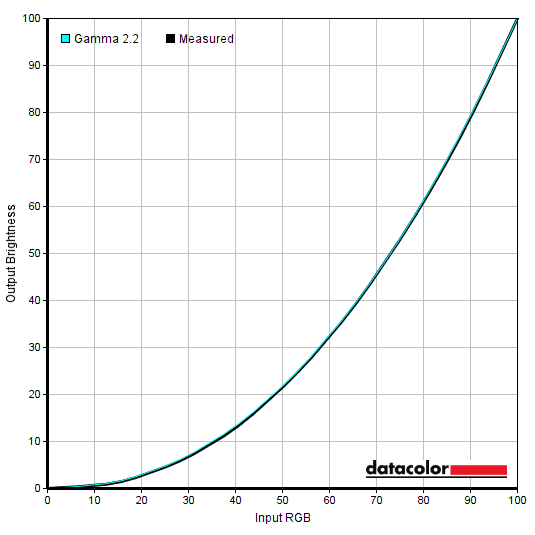
Gamma 'Test Settings'
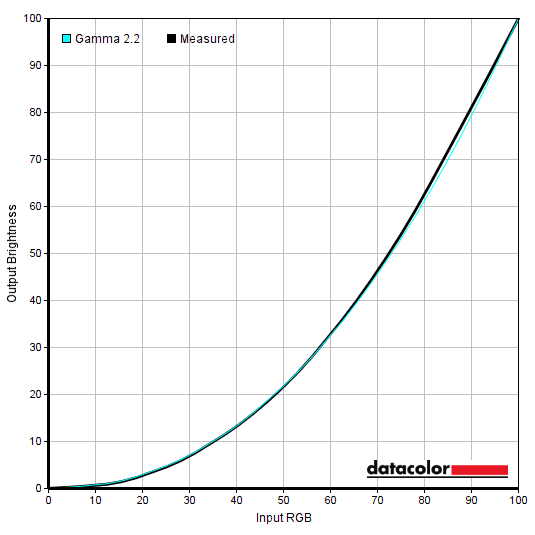
Gamma, '60' contrast (default)
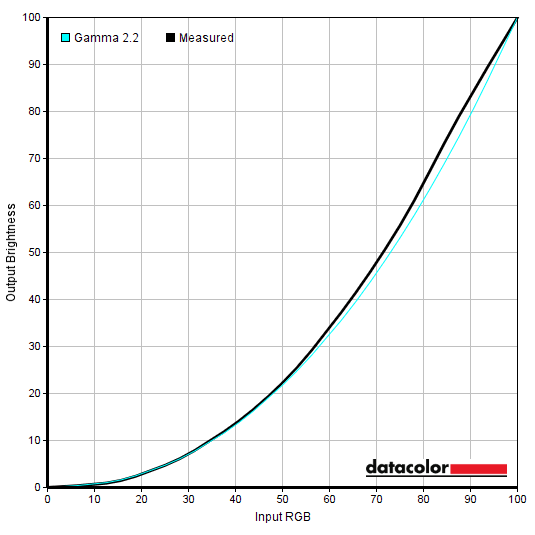
Gamma, '65' contrast

Gamma, '70' contrast

Gamma, sRGB '70' contrast (default)
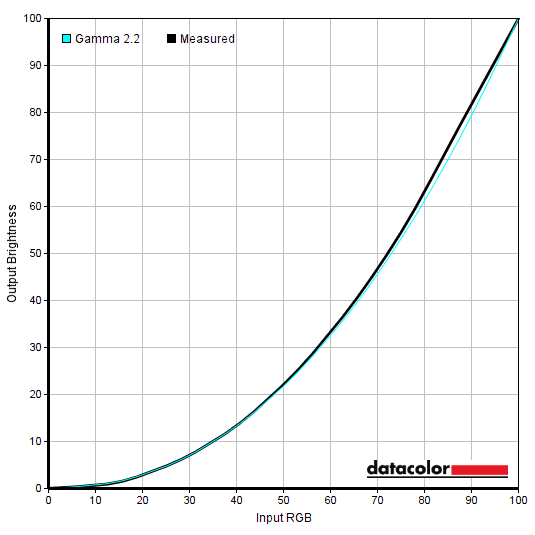
Gamma, sRGB '60' contrast
Test Settings
Contrast and brightness
Contrast ratios
Monitor Settings White luminance (cd/m²) Black luminance (cd/m²) Contrast ratio (x:1) 100% brightness (Factory Defaults) 187 - 204 0.00 ∞:1 80% brightness 121 - 131 0.00 ∞:1 60% brightness 79 - 85 0.00 ∞:1 40% brightness 45 - 47 0.00 ∞:1 20% brightness 26 0.00 ∞:1 0% brightness 14 - 15 0.00 ∞:1 Contrast = 65 207 - 227 0.00 ∞:1 Contrast = 70 190 - 242 0.00 ∞:1 Smart Energy Saving = High 121 - 205 0.00 ∞:1 Smart Energy Saving = Low 162 - 204 0.00 ∞:1 Gamer 2 setup per Gamer 1 defaults 203 - 241 0.00 ∞:1 HDR Gamer 1 / HDR Gamer 2 (1% white, peak)* 614 / 910 0.00 ∞:1 HDR Gamer 1 / HDR Gamer 2 (4% white, peak)* 653 / 863 0.00 ∞:1 HDR Gamer 1 / HDR Gamer 2 (9% white, peak)* 665 / 793 0.00 ∞:1 HDR Gamer 1 / HDR Gamer 2 (25% white, peak)* 413 / 432 0.00 ∞:1 HDR Gamer 1 / HDR Gamer 2 (49% white, peak)* 236 / 252 0.00 ∞:1 HDR Gamer 1 / HDR Gamer 2 (100% white, sustained)** 142 / 152 N/A N/A HDR Gamer 1, Game Scene 1 (SOTTR water glint)*** 660 N/A N/A HDR Gamer 1, Game Scene 2 (BFV mountain sun)*** 358 N/A N/A Gamma = Mode 1 195 - 210 0.00 ∞:1 Gamma = Mode 3 190 - 204 0.00 ∞:1 Gamma = Mode 4 192 - 206 0.00 ∞:1 sRGB 120 - 137 0.00 ∞:1 sRGB (100% brightness) 148 - 167 0.00 ∞:1 sRGB (100% brightness, 60 contrast) 130 - 142 0.00 ∞:1 Vivid (100% brightness) 153 - 406 0.00 ∞:1 Color Temp = Warm 180 - 196 0.00 ∞:1 Reader 111 - 116 1.28 87 - 91 Color Temp = Manual - W8 144 - 161 0.00 ∞:1 Calibration 1 (‘sRGB’ hardware calibration applied, 160 cd/m² / 6500K / 2.2 gamma) 154 - 172 0.00 ∞:1 Calibration 2 (‘sRGB’ hardware calibration applied, Max - 200 cd/m² / 6500K / 2.2 gamma) 186 - 211 0.00 ∞:1 Test Settings 154 - 166 0.00 ∞:1 Test Settings (100% brightness) 170 - 185 0.00 ∞:1
*HDR measurements were made using this YouTube HDR brightness test video, running full screen at ‘1440p HDR’ on Microsoft Edge. The maximum reading using the patch size (measurement area) specified in the table was used. The black luminance was taken at the same point of the video with the colorimeter offset to the side of the white test patch, equidistant between the test patch and edge of the monitor bezel.
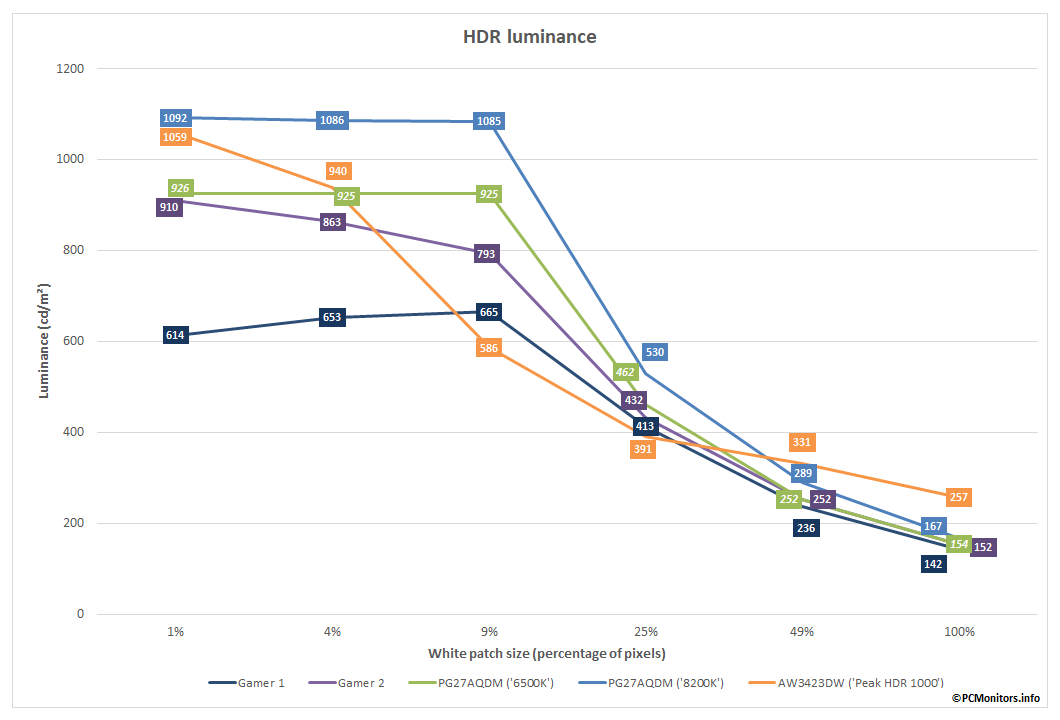
In this graph you can see that the AW3423DW provides a superior peak brightness at 1% and 4% patch size compared to the 27GR95QE, even if using the poorly balanced ‘Gamer 2’ setting on the LG. At a 9% patch size the LG has an edge in brightness, even using ‘Gamer 1’, with both screens performing similarly at a 25% patch size and the AW3423DW showing a bit of an edge at 49% and 100% patch sizes. The PG27AQDM offers superior brightness performance to the LG at 1, 4% and 9% patch sizes even if you use ‘Gamer 2’ on the LG and the ‘6500K’ setting on the ASUS. We draw subjective comparisons later on to explain how this all applies to normal HDR content.
PWM (Pulse Width Modulation)
Luminance uniformity

The SpyderX Elite was used to assess the uniformity of lighter shades, represented by 9 equally spaced white quadrants running from the top left to bottom right of the screen. The table below shows the luminance recorded at each quadrant as well as the percentage deviation between each quadrant and the brightest recorded point.

Luminance uniformity table
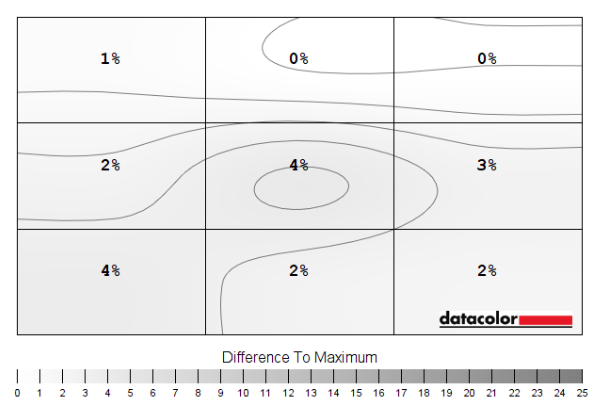
Luminance uniformity map
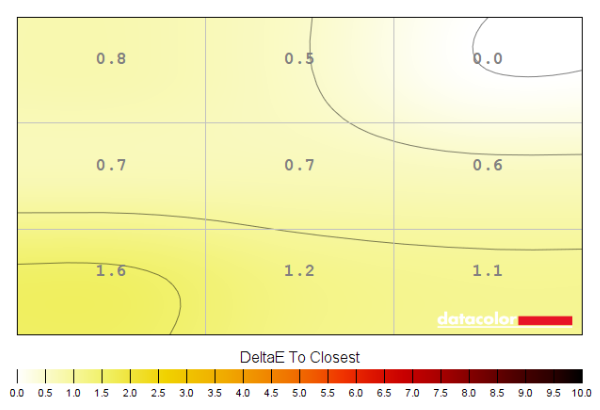
Colour temperature uniformity map
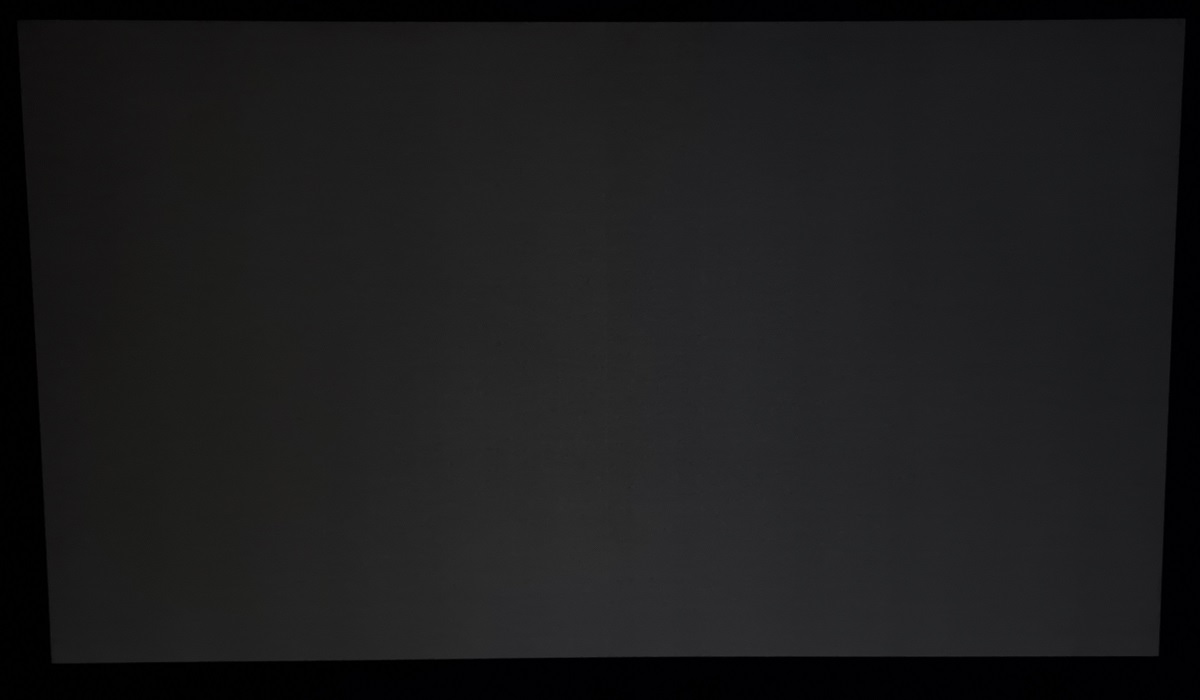
*This monitor includes a feature called CPC (Convex Power Control) which is also found on various LG OLED TVs. This causes the screen to dim towards the edges, mainly near the corners, to reduce power consumption at the expense of uniformity. This can come into play most noticeably where bright shades dominate, including on the desktop when a lot of white space is displayed. It may also appear at times with darker shade combinations. It didn’t activate during this test, even if we shifted the corner measurement area so it was very close to the bezels. That’s because the test includes a white square with most of the screen showing black. The Datacolor SpyderX software’s colour channel adjustment page includes a lot of white space. Here, we measured ~160 cd/m² for the centre and ~130 cd/m² towards the corners of the screen. Indicating that the corners are ~23% dimmer than centre. Interestingly the image ‘stabilised’ and the corners brightened up to ~160 cd/m² after 30 seconds or so. CPC can create a sort of ‘vignette’ when it activates – some people won’t notice this and it doesn’t look all that different to an average LCD in terms of brightness uniformity. But it stood out to us compared to other OLED models we tested, more so on the desktop where it’s more readily noticed. CPC can be disabled in the service menu using certain remote controls (MKJ39170828). With this remote you can access the service menu by pressing ‘IN START’ which on the remote we used was above and to the left of the navigational button. Set ‘AGING’ to ‘ON’ (1), close the service menu and re-open it, then enter the ‘DEBUG Module OLED’ section (2). From there, set ‘CPC enable’ to ‘OFF’ (3) and back out of the service menu. We’d recommend being careful not to change additional settings in the service menu and if possible setting everything up how it was (including setting ‘AGING’ to ‘OFF’) if you need to send your monitor in for service for any reason. This setting should really be something the user can easily disable, even in the normal OSD, as there’s no tangible real-world benefit to this setting aside from a slight reduction in power consumption. Some other models sharing the panel (such as the PG27AQDM) don’t have such a feature. There are a couple of things to bear in mind when using this setting:
Contrast in games and movies
Lagom contrast tests
Colour reproduction
Colour gamut
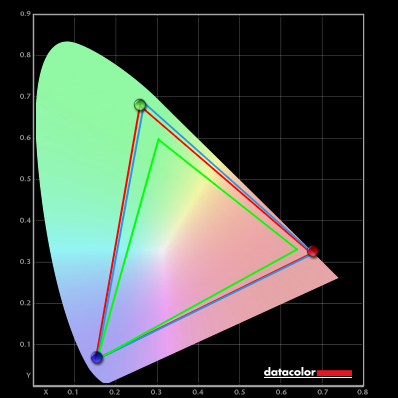
Colour gamut 'Test Settings'
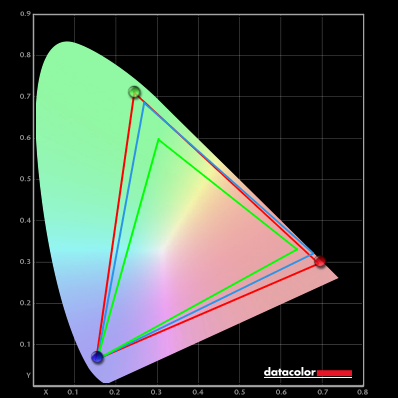
Colour gamut QD-OLED (AW3423DW)
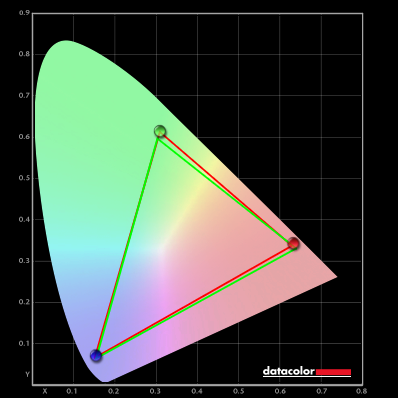
Colour gamut 'sRGB'
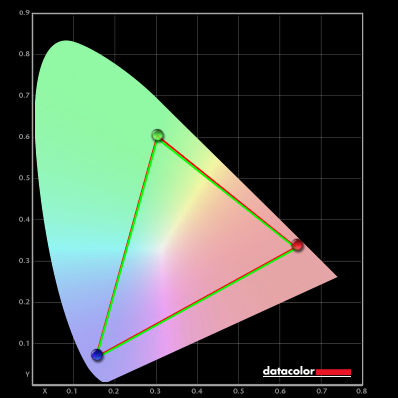
Colour gamut, sRGB hardware calibration

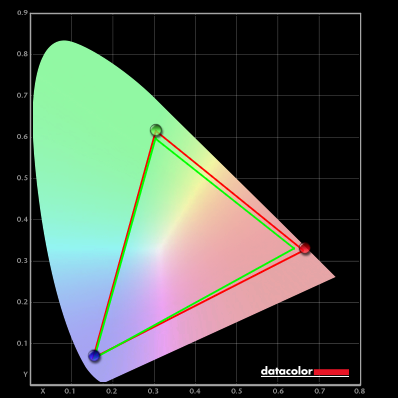
Colour gamut AMD 'CTC disabled'
Colour in games and movies
Shade representation using SpyderCHECKR 24
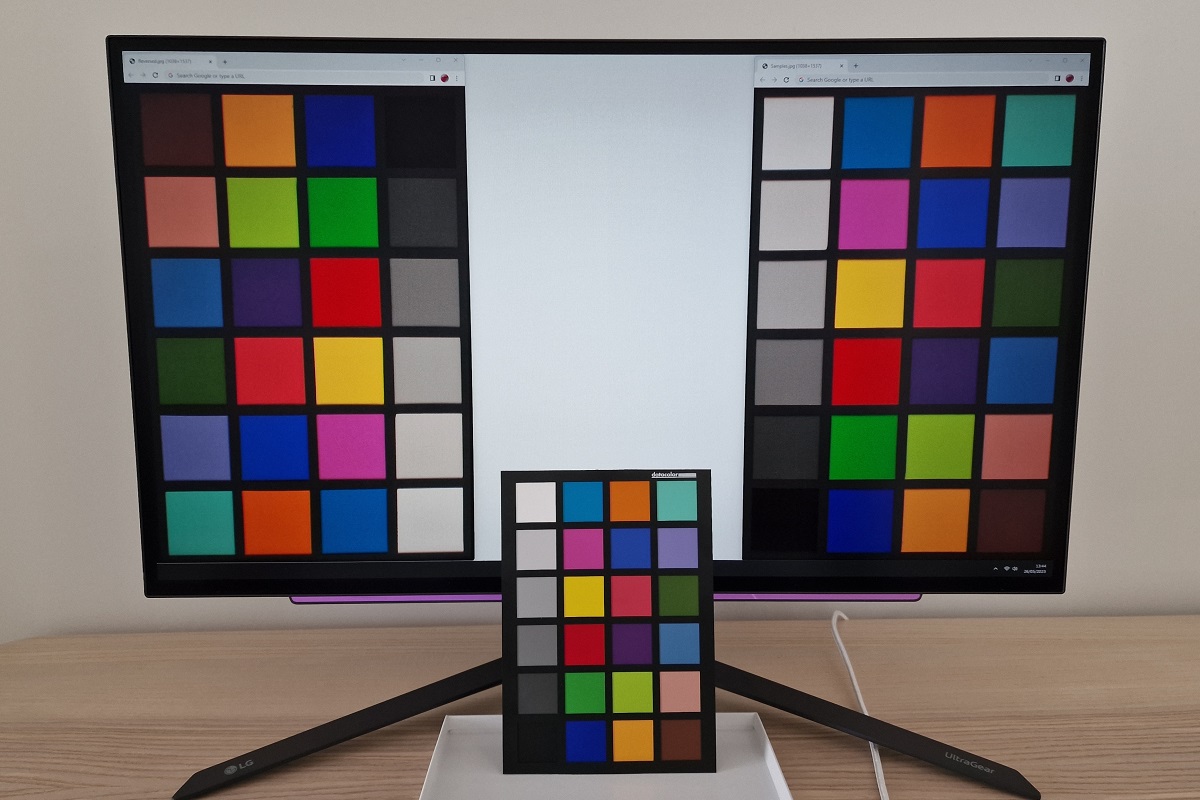
The monitor presents colours in a vibrant way, with most shades showing varying degrees of oversaturation. There’s a significantly deeper and punchier than intended look to medium orange (3), tango pink (11) and candy apple red (14) with Persian pink (6) and lemon yellow (10) showing a bit of extra saturation. Peach pink (20) and light chocolate brown (24) show a red push, whilst gamboge (23) appears with more of a saffron hue than intended. This is all due primarily to the significant extension in the red region of the gamut. There’s also a punchier look to dark lime green (18) and yellow green (19), but not to the extent observed on some models with an even more generous gamut in the green region. Cerulean (2), Persian blue (7) and to a lesser extent aquamarine (4) are displayed with a more vibrant blue push than intended, though again not as strong as we’ve seen on some models with more generous Adobe RGB coverage and hence more blue to green energy. The colour consistency was strong, though, without the clear saturation shifts you’d observe on VA or TN models depending on the on-screen shade position. Some of the discrepancies here are due to slight uniformity issues on our unit or slight extra glare at some points. Illuminating the printed sheet properly whilst entirely avoiding glare on the screen is challenging. The image below shows how things appear using the sRGB emulation mode (‘Game Mode’ set to ‘sRGB’). Contrast was set to our preferred value of ‘60’, although setting that to ‘70’ didn’t change the output here aside from raising brightness at a given OSD setting.
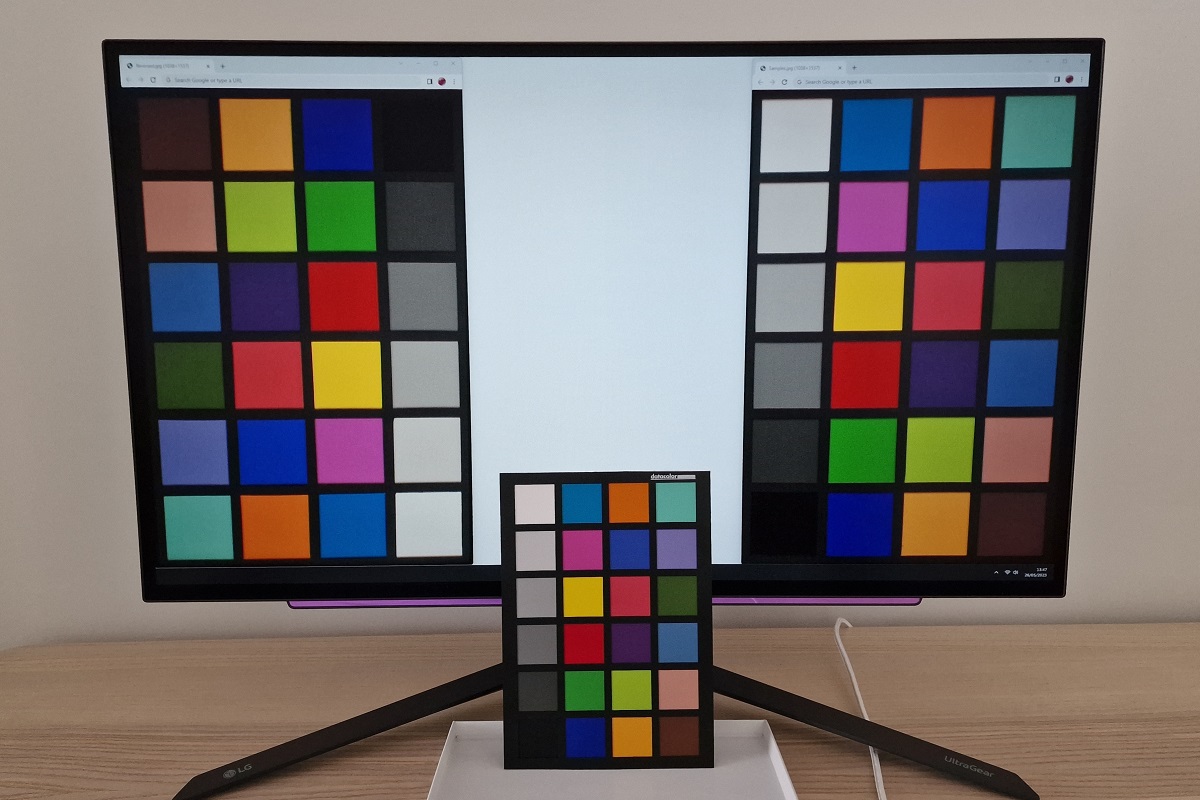
Saturation levels are significantly reduced now, with a more appropriate representation to most shades. Cerulean (2) and grey blue (16) are somewhat deeper than intended, with lilac (8) appearing with an overly blue tint. The cool colour temperature contributes in part to these imbalances and that can be corrected. Persian pink (6) appears slightly too pastel and undersaturated. The remaining shades are represented quite well, with saturation levels suitably toned down compared to using the native gamut. As usual, we’d recommend profiling the monitor with your own colorimeter or spectrophotometer if you require the highest level of colour accuracy.
Viewing angles
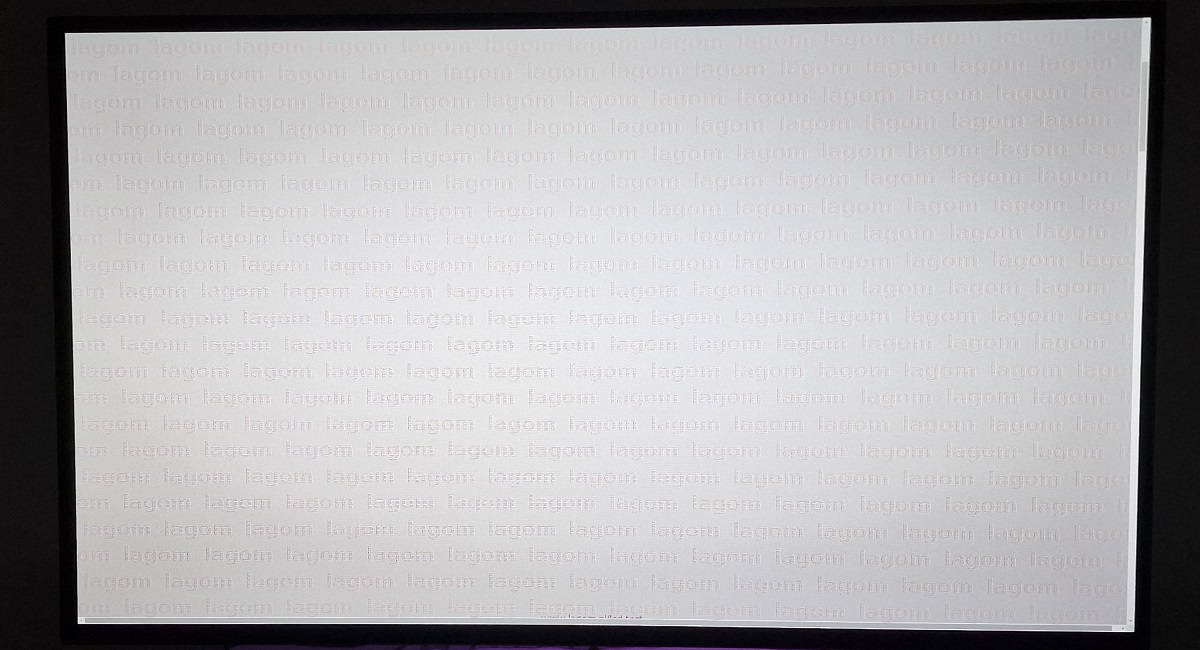
The video below shows the Lagom text test, a mixed desktop background, game scene and dark desktop background from various viewing angles. You can see the CPC behaviour explored earlier kicking in for the Lagom text test, though this is exaggerated in the video. The shifts in the image including contrast, colour and the representation of black are extremely minor. Performance here is much stronger than on any LCD we’ve observed and almost looks like you’re viewing a picture rather than a screen due to the strong consistency here.
Interlace pattern artifacts
Responsiveness
Input lag
Perceived blur (pursuit photography)
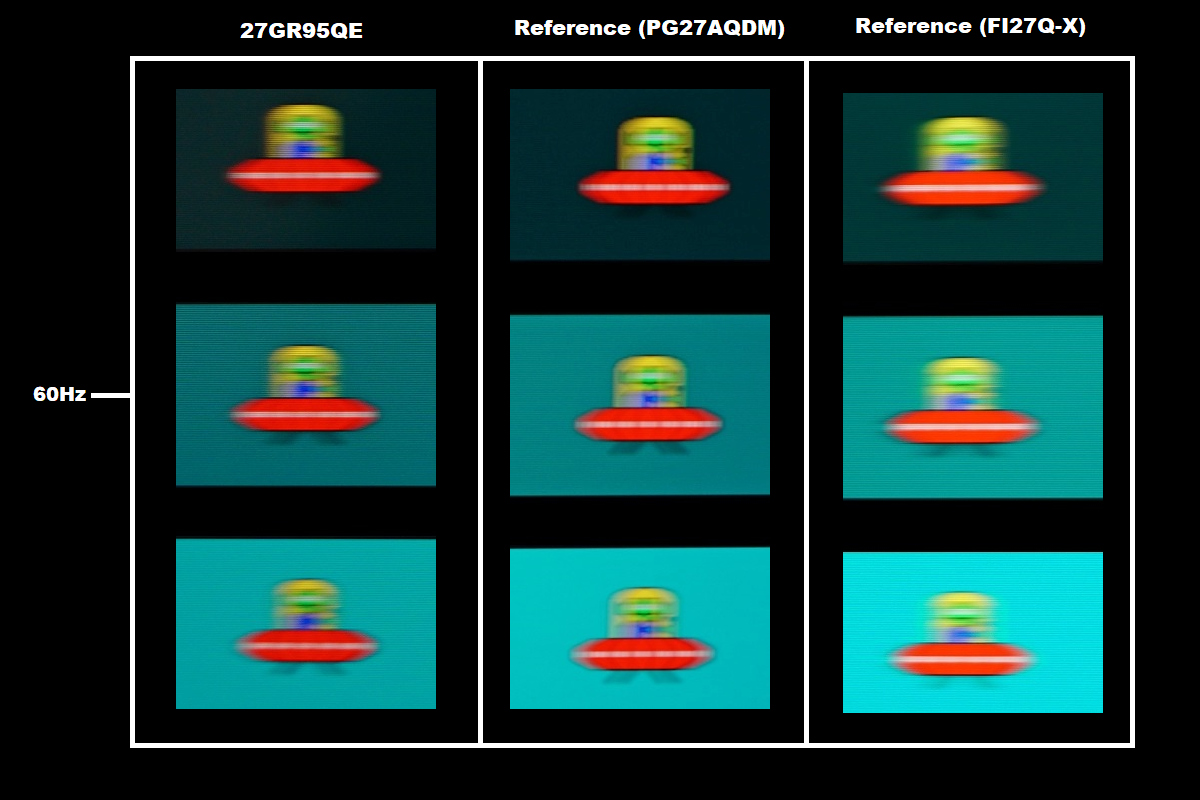

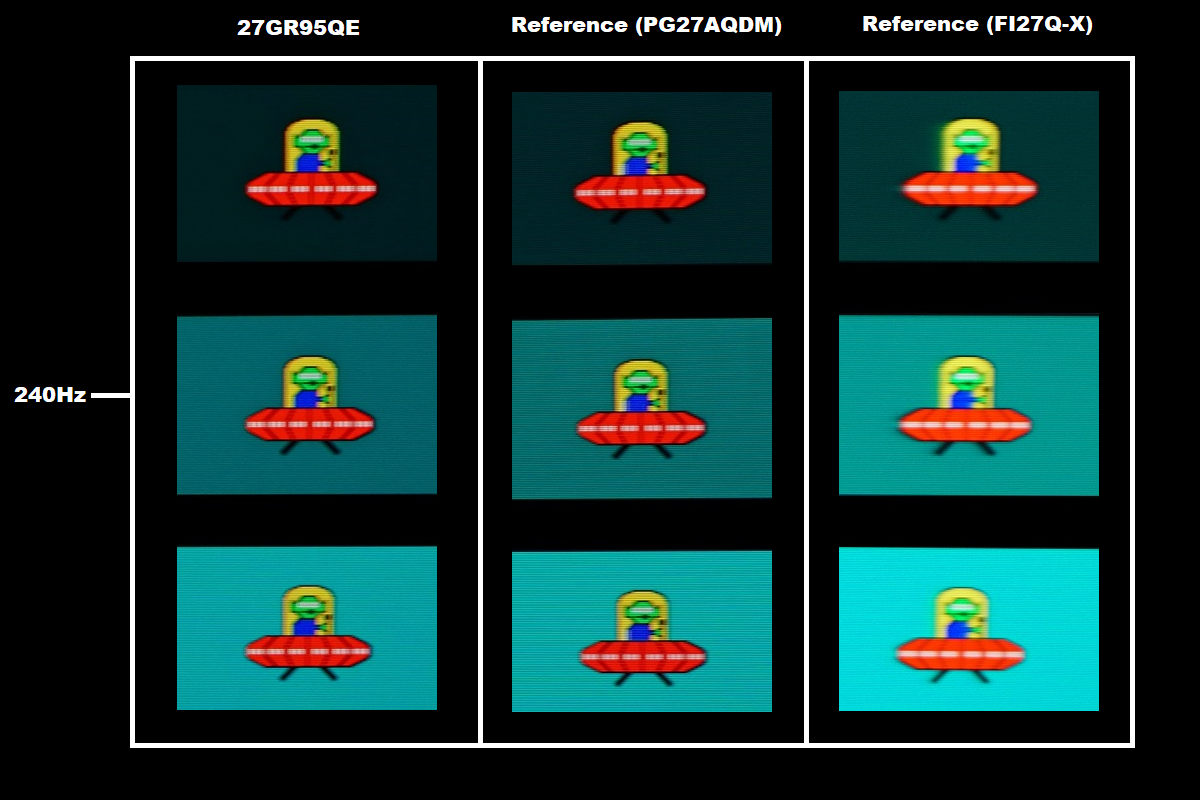
Responsiveness in games and movies

VRR (Variable Refresh Rate) technology
FreeSync – the technology and activating it

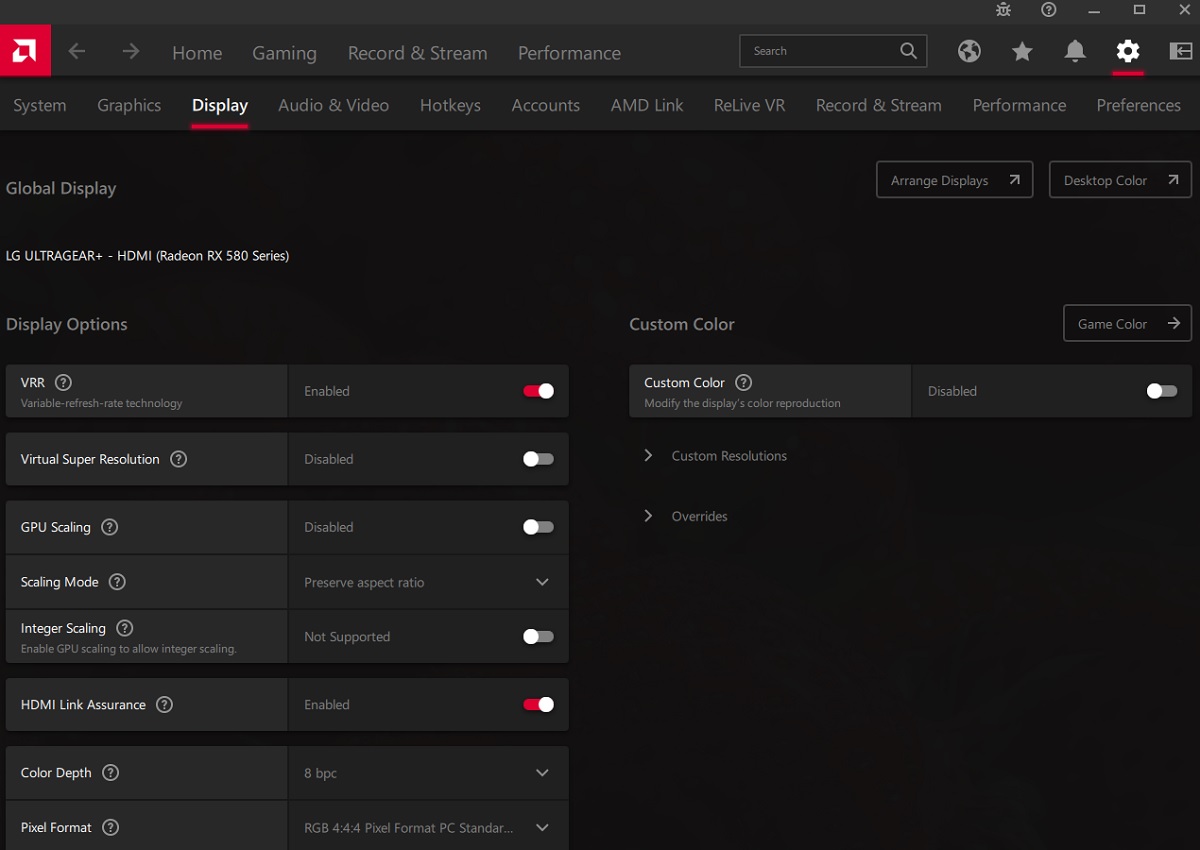
The LG supports a variable refresh rate range of 48 – 240Hz. That means that if the game is running between 48fps and 240fps, the monitor will adjust its refresh rate to match. When the frame rate rises above 240fps, the monitor will stay at 240Hz and the GPU will respect your selection of ‘VSync on’ or ‘VSync off’ in the graphics driver. With ‘VSync on’ the frame rate will not be allowed to rise above 240fps, at which point VSync activates and imposes the usual associated latency penalty. With ‘VSync off’ the frame rate is free to climb as high as the GPU will output (potentially >240fps). AMD LFC (Low Framerate Compensation) is also supported by this model, which means that the refresh rate will stick to multiples of the frame rate where it falls below the 48Hz (48fps) floor of operation for FreeSync. If a game ran at 33fps, for example, the refresh rate would be 66Hz to help keep tearing and stuttering at bay. LFC usually activated at a slightly higher refresh rate of 55Hz or just slightly below – this slightly different floor of operation makes little difference in practice. This feature is used regardless of VSync setting, so it’s only above the ceiling of operation where the VSync setting makes a difference.
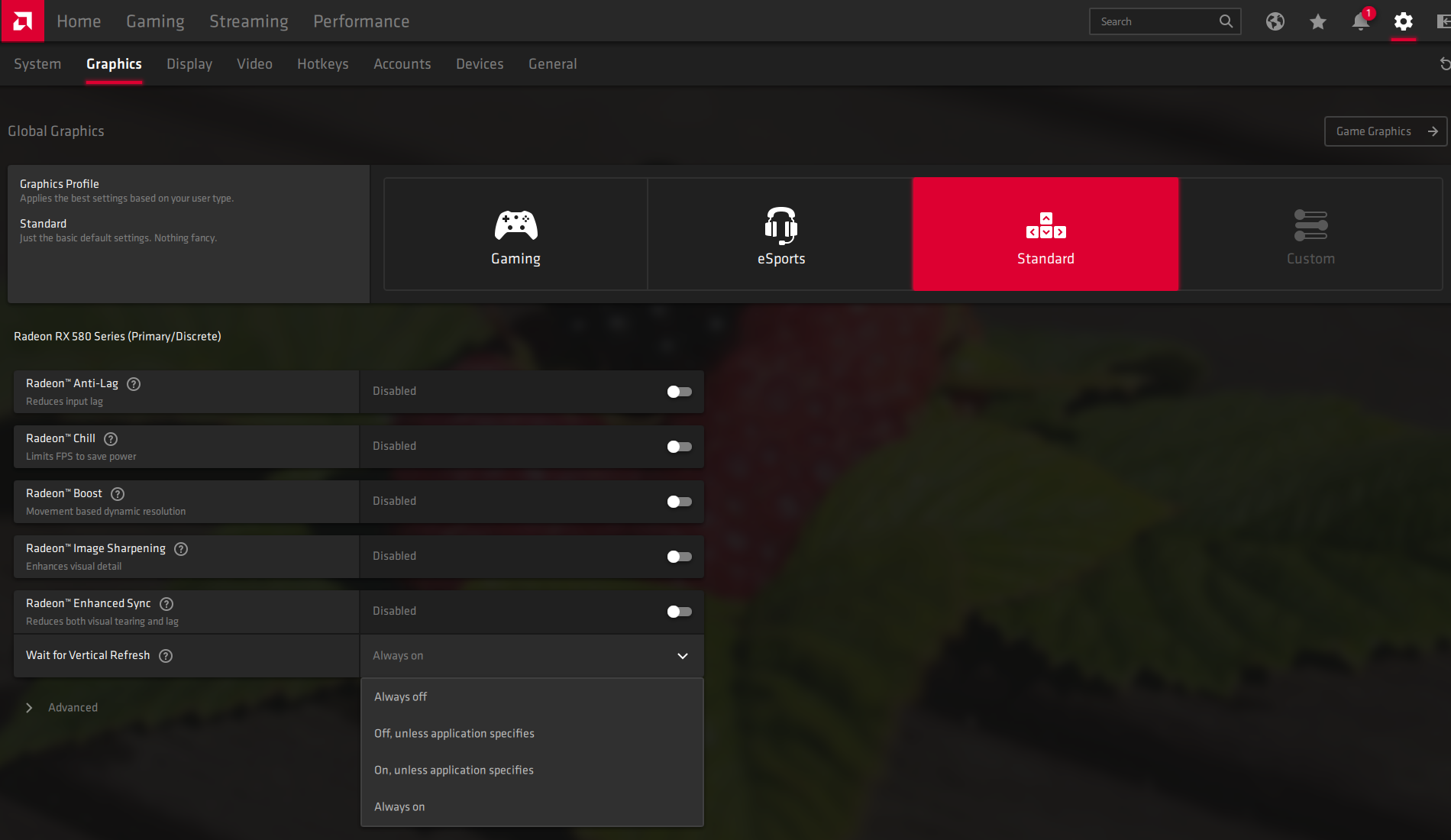
Some users prefer to leave VSync enabled but use a frame rate limiter set a few frames below the maximum supported (e.g. 237fps) instead, avoiding any VSync latency penalty at frame rates near the ceiling of operation or tearing from frame rates rising above the refresh rate. If you go to the ‘Game Adjust’ section of the OSD and enable the ‘FPS Counter’ feature, it will display the refresh rate of the display. This will reflect the frame rate if it’s within the main VRR window. The final point to note is that FreeSync only removes stuttering or juddering related to mismatches between frame rate and refresh rate. It can’t compensate for other interruptions to smooth game play, for example network latency or insufficient system memory. Some game engines will also show stuttering (or ‘hitching’) for various other reasons which won’t be eliminated by the technology.
FreeSync – the experience
Nvidia Adaptive-Sync (‘G-SYNC Compatible’)
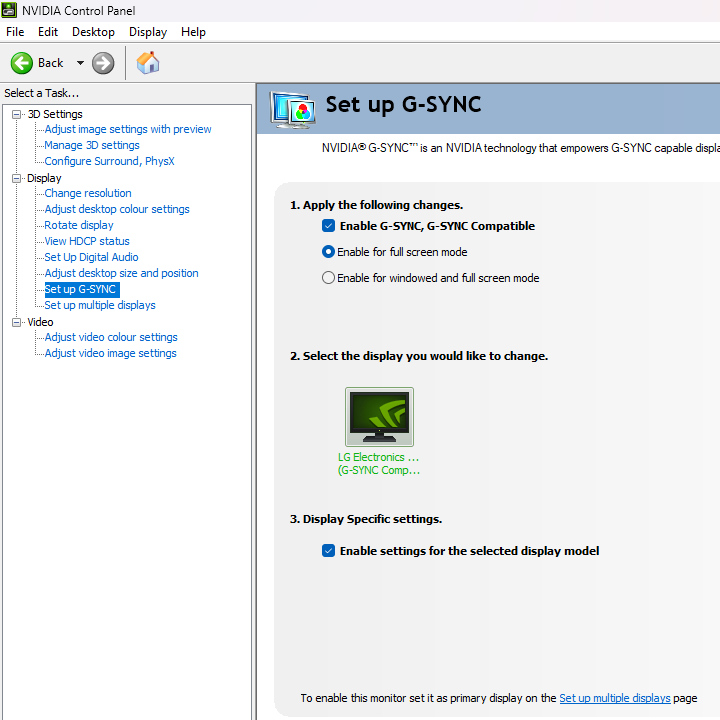
You will also see in the image above that it states: “Selected Display is not validated as G-SYNC Compatible.” This means Nvidia hasn’t specifically tested and validated the display, not that it won’t work. On our RTX 3090 the experience was very similar to what we described with FreeSync. With the technology getting rid of tearing and stuttering from what would otherwise be frame and refresh rate mismatches, within the VRR range. Similar VRR flickering behaviour was observed, mainly with heavy fluctuations in frame rate and hence refresh rate. An LFC-like frame to refresh multiplication technology was employed below that to keep tearing and stuttering from frame and refresh rate mismatches at bay, which seemed to activate ~60Hz or a touch below which is slightly higher than on the AMD side. This doesn’t make a lot of difference in practice, unless your frame rate happens to be hovering around very specific values either side of this. There was again a reasonably subtle momentary stuttering and potential flickering as the boundary was crossed, as we observed with our AMD GPU as well. Our suggestions regarding use of VSync also apply, but you’re using Nvidia Control Panel rather than AMD Software to control this. The setting is found in ‘Manage 3D settings’ under ‘Vertical sync’, where the final option (‘Fast’) is equivalent to AMD’s ‘Enhanced Sync’ setting. You’ll also notice ‘G-SYNC Compatible’ listed under ‘Monitor Technology’ in this section, as shown below. Make sure this is selected (it should be if you’ve set everything up correctly in ‘Set up G-SYNC’).
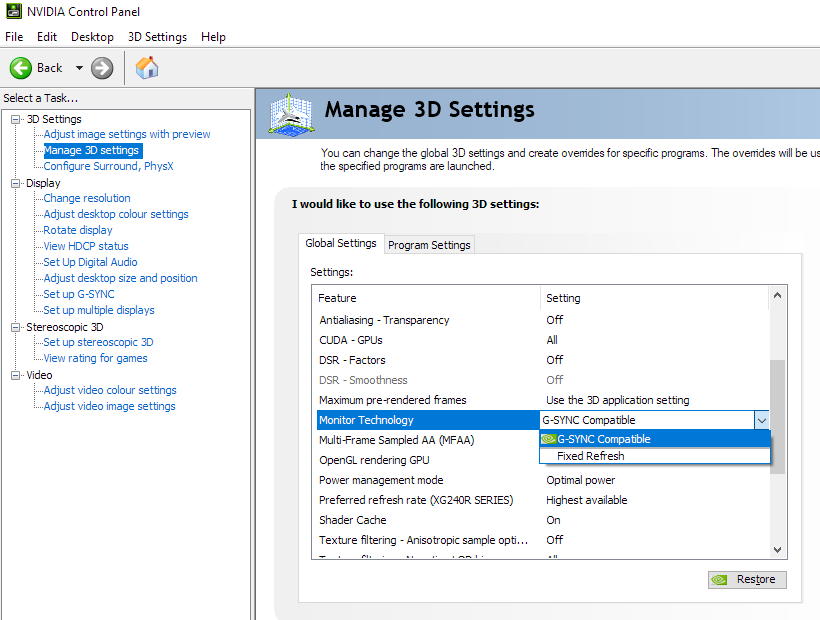
Note again that you can activate the ‘FPS Counter’ feature in the ‘Game Adjust’ section of the OSD. This will display the refresh rate of the display and therefore indicates the frame rate if that is within the VRR window (~60 – 240Hz). This is a useful indication that the technology is active. And as with AMD FreeSync Premium, HDR can be used at the same time as ‘G-SYNC Compatible’.
HDMI 2.1 VRR
HDR (High Dynamic Range)
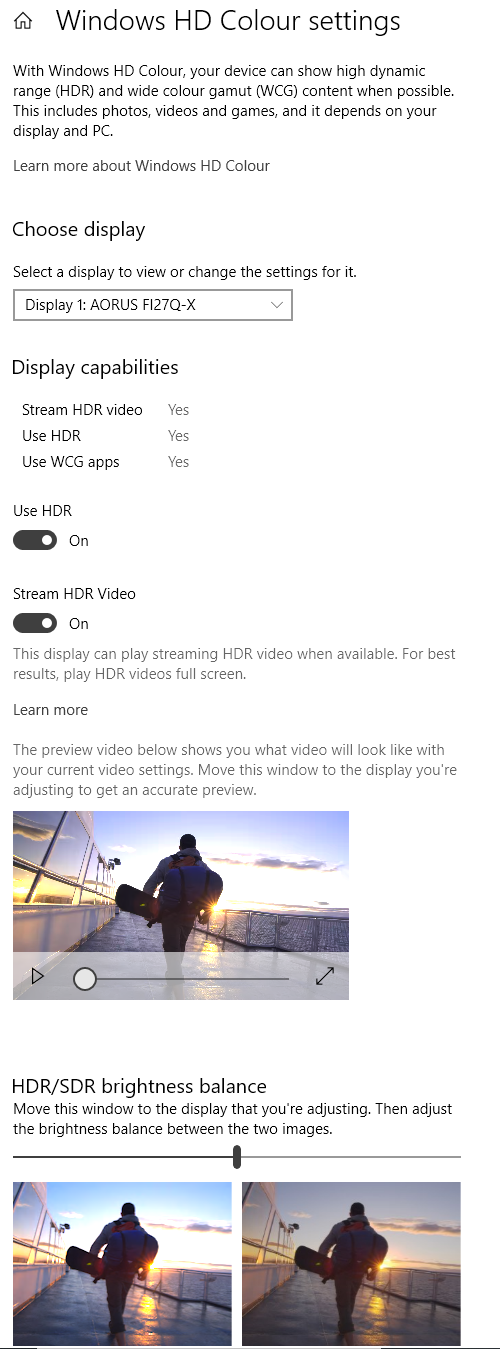
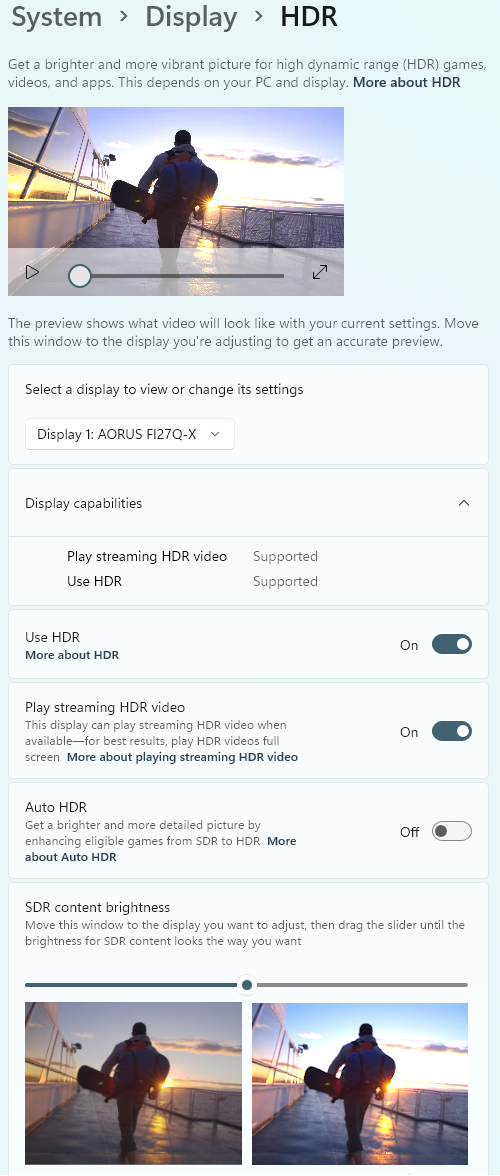

Colour gamut 'Test Settings'
As a reminder, we recorded 97% DCI-P3 coverage as shown in the image above. With a red triangle showing the monitor, blue triangle DCI-P3 and green triangle sRGB. This coverage combined with the very strong colour consistency and contrast performance allowed the monitor to deliver a good amount of vibrancy where intended by the developers. Brightly painted red and purple objects, orange berries and some of Lara’s ornate blue dresses to give just a few examples. Because developers are targeting wider colour spaces than sRGB, the oversaturation observed under SDR wasn’t present. Earthy browns and skin tones appeared appropriately rich but neutral, without an undesirable red push. Vegetation showcased a nice array of fairly deep and lush greens with more muted and minty shades mixed in – again, without overdone yellowish greens or overly bright and eye-catching shades. The overall look was certainly vibrant and the monitor showed better balance to its colours than the PG27AQDM we reviewed, which showed some shades such as bright oranges, yellows, rich earthy colours and some greens in an undersaturated or somewhat ‘muddy’ way for example. These differences may not be clear when viewing the monitor in isolation, but we did some comparative testing of specific scenes and the LG gave certain elements a more appropriate look.
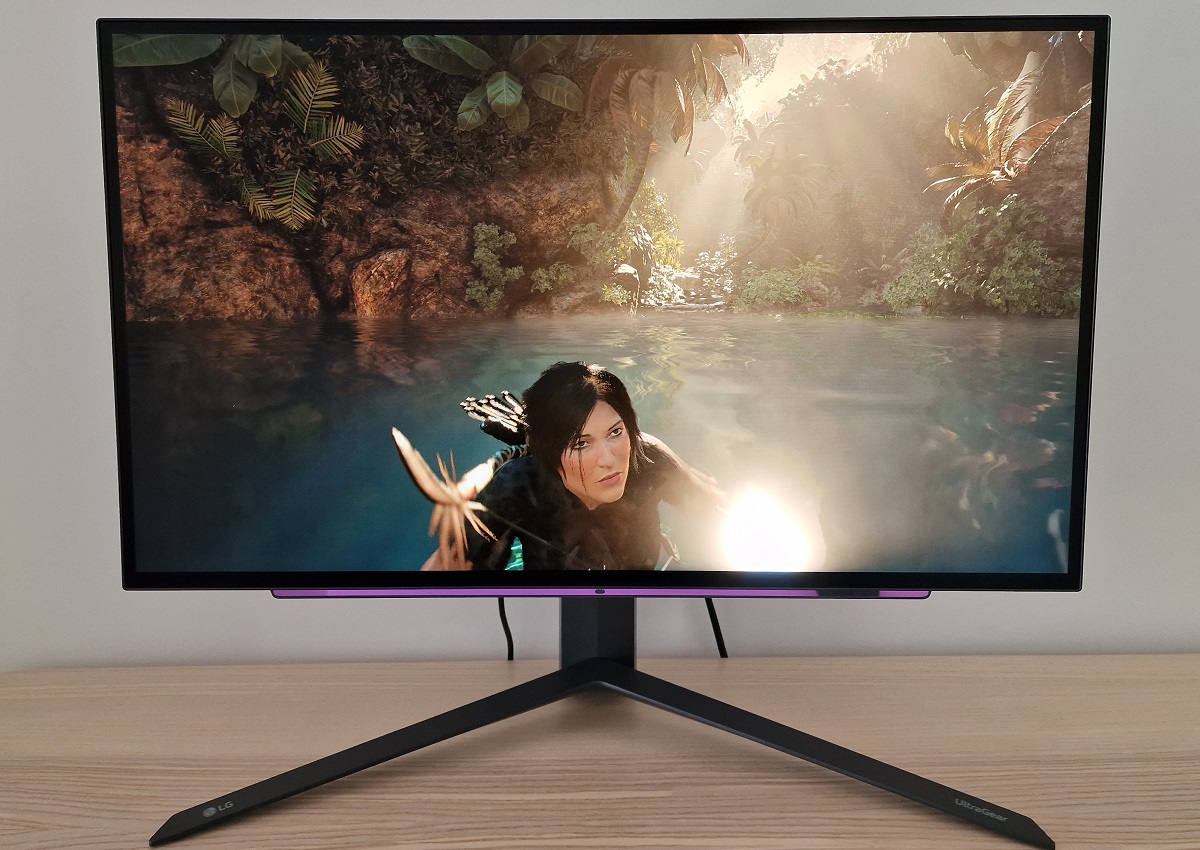
Interpolation and upscaling
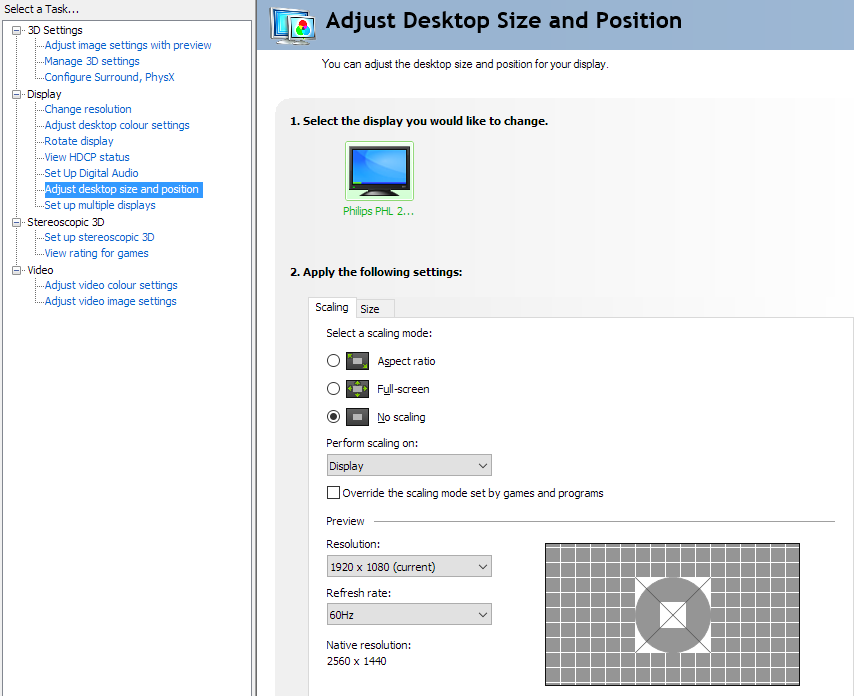
The monitor has a few ‘Aspect Ratio’ settings under ‘Input’. There’s ‘Full Wide’ which uses an interpolation process to fill up all pixels of the monitor. There’s ‘Original’ which uses an interpolation process to fill up as many pixels as possible whilst still respecting the aspect ratio (black borders around the image for some resolutions). And there’s ‘Just Scan’ available if Adaptive-Sync is disabled, which is a 1:1 pixel mapping feature that just uses the pixels called for in the source resolution, presenting things with no distortion and a black area for unused pixels. When running 1920 x 1080 (Full HD or 1080p) using the ‘Full Wide’ or ‘Original’ setting and a refresh rate where monitor scaling is supported, the interpolation process used by the monitor gave a softer look than a native Full HD screen of the size. This could be offset to a good degree by increasing ‘Sharpness’ to ‘60’ or ‘70’ – this didn’t gave quite the same look as a native Full HD screen of the size, but gave a decent representation overall without strong over-sharpening or excessive softness. With the monitor set to 3840 x 2160 (‘4K’ UHD), the downsampling mode worked much as we’ve seen on other models with the feature. It doesn’t appear like a native 27” UHD model as this monitor doesn’t benefit from the same tight pixel density. But it looks quite crisp, as if very strong anti-aliasing and a bump up in texture resolution has been applied to the game.
Video review
Timestamps:
Subpixels and Fringing
Image Retention and Burn-in
Features & Aesthetics
Contrast
Colour reproduction
HDR (High Dynamic Range)
Responsiveness (General)
Responsiveness (VRR)
Conclusion
Positives Negatives Vibrant output with very strong colour consistency, good DCI-P3 coverage, a fairly flexible sRGB emulation setting and hardware calibration
Poor ‘out the box’ setup with respect to white point, limited Adobe RGB or Rec. 2020 coverage and low-end gamma slightly high giving slight detail loss in places Exceptional static contrast performance, effective glare-handling from the screen surface and HDR which provides reasonable bursts of brightness and vibrant (but appropriate) colour output A bit of a grainy look and hazing from ambient lighting due to screen surface, limited brightness and inability to show appropriate saturation at high brightness due to unfiltered white subpixel Exceptional pixel responsiveness without perceived overshoot at any refresh rate, exceptionally low input lag and good VRR support including full bandwidth HDMI 2.1 No BFI or pixel strobing option and some VRR flickering for dark to medium-dark shades during significant frame rate fluctuations Good ‘feel’ to stand with good ergonomic flexibility, decent pixel density and ‘desktop real estate’ from the resolution plus a feature-rich OSD with intuitive control via remote Expensive for a QHD option, fringing (plus image retention and burn-in concerns) make it less than ideal for heavy productivity usage, OSD system for monitor’s own joystick limited and frustrating


